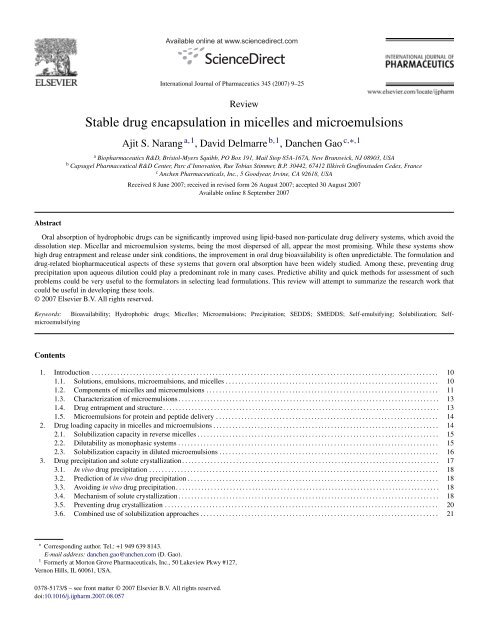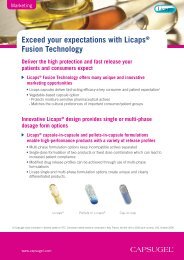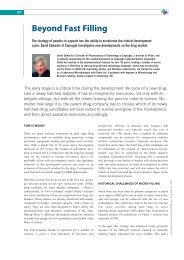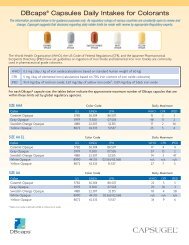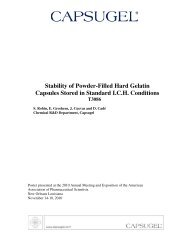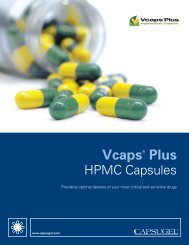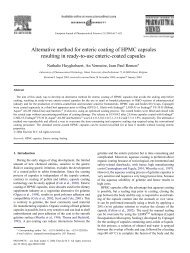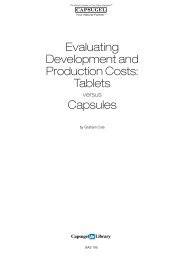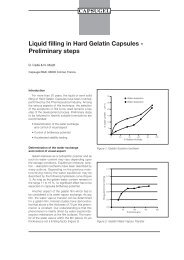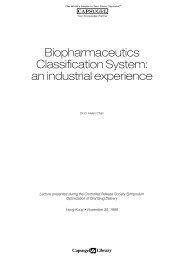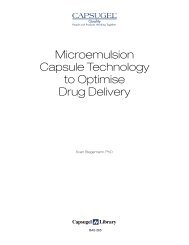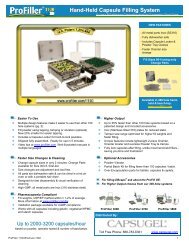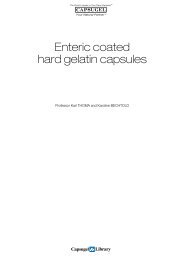Stable drug encapsulation in micelles and microemulsions - Capsugel
Stable drug encapsulation in micelles and microemulsions - Capsugel
Stable drug encapsulation in micelles and microemulsions - Capsugel
You also want an ePaper? Increase the reach of your titles
YUMPU automatically turns print PDFs into web optimized ePapers that Google loves.
Available onl<strong>in</strong>e at www.sciencedirect.comInternational Journal of Pharmaceutics 345 (2007) 9–25Review<strong>Stable</strong> <strong>drug</strong> <strong>encapsulation</strong> <strong>in</strong> <strong>micelles</strong> <strong>and</strong> <strong>microemulsions</strong>Ajit S. Narang a,1 , David Delmarre b,1 , Danchen Gao c,∗,1a Biopharmaceutics R&D, Bristol-Myers Squibb, PO Box 191, Mail Stop 85A-167A, New Brunswick, NJ 08903, USAb <strong>Capsugel</strong> Pharmaceutical R&D Center, Parc d’Innovation, Rue Tobias Stimmer, B.P. 30442, 67412 Illkirch Graffenstaden Cedex, Francec Anchen Pharmaceuticals, Inc., 5 Goodyear, Irv<strong>in</strong>e, CA 92618, USAReceived 8 June 2007; received <strong>in</strong> revised form 26 August 2007; accepted 30 August 2007Available onl<strong>in</strong>e 8 September 2007AbstractOral absorption of hydrophobic <strong>drug</strong>s can be significantly improved us<strong>in</strong>g lipid-based non-particulate <strong>drug</strong> delivery systems, which avoid thedissolution step. Micellar <strong>and</strong> microemulsion systems, be<strong>in</strong>g the most dispersed of all, appear the most promis<strong>in</strong>g. While these systems showhigh <strong>drug</strong> entrapment <strong>and</strong> release under s<strong>in</strong>k conditions, the improvement <strong>in</strong> oral <strong>drug</strong> bioavailability is often unpredictable. The formulation <strong>and</strong><strong>drug</strong>-related biopharmaceutical aspects of these systems that govern oral absorption have been widely studied. Among these, prevent<strong>in</strong>g <strong>drug</strong>precipitation upon aqueous dilution could play a predom<strong>in</strong>ant role <strong>in</strong> many cases. Predictive ability <strong>and</strong> quick methods for assessment of suchproblems could be very useful to the formulators <strong>in</strong> select<strong>in</strong>g lead formulations. This review will attempt to summarize the research work thatcould be useful <strong>in</strong> develop<strong>in</strong>g these tools.© 2007 Elsevier B.V. All rights reserved.Keywords: Bioavailability; Hydrophobic <strong>drug</strong>s; Micelles; Microemulsions; Precipitation; SEDDS; SMEDDS; Self-emulsify<strong>in</strong>g; Solubilization; Selfmicroemulsify<strong>in</strong>gContents1. Introduction ............................................................................................................. 101.1. Solutions, emulsions, <strong>microemulsions</strong>, <strong>and</strong> <strong>micelles</strong> ................................................................... 101.2. Components of <strong>micelles</strong> <strong>and</strong> <strong>microemulsions</strong> ......................................................................... 111.3. Characterization of <strong>microemulsions</strong> .................................................................................. 131.4. Drug entrapment <strong>and</strong> structure....................................................................................... 131.5. Microemulsions for prote<strong>in</strong> <strong>and</strong> peptide delivery ...................................................................... 142. Drug load<strong>in</strong>g capacity <strong>in</strong> <strong>micelles</strong> <strong>and</strong> <strong>microemulsions</strong> ....................................................................... 142.1. Solubilization capacity <strong>in</strong> reverse <strong>micelles</strong> ............................................................................ 152.2. Dilutability as monophasic systems .................................................................................. 152.3. Solubilization capacity <strong>in</strong> diluted <strong>microemulsions</strong> ..................................................................... 163. Drug precipitation <strong>and</strong> solute crystallization................................................................................. 173.1. In vivo <strong>drug</strong> precipitation ........................................................................................... 183.2. Prediction of <strong>in</strong> vivo <strong>drug</strong> precipitation ............................................................................... 183.3. Avoid<strong>in</strong>g <strong>in</strong> vivo <strong>drug</strong> precipitation................................................................................... 183.4. Mechanism of solute crystallization .................................................................................. 183.5. Prevent<strong>in</strong>g <strong>drug</strong> crystallization ...................................................................................... 203.6. Comb<strong>in</strong>ed use of solubilization approaches ........................................................................... 21∗ Correspond<strong>in</strong>g author. Tel.: +1 949 639 8143.E-mail address: danchen.gao@anchen.com (D. Gao).1 Formerly at Morton Grove Pharmaceuticals, Inc., 50 Lakeview Pkwy #127,Vernon Hills, IL 60061, USA.0378-5173/$ – see front matter © 2007 Elsevier B.V. All rights reserved.doi:10.1016/j.ijpharm.2007.08.057
10 A.S. Narang et al. / International Journal of Pharmaceutics 345 (2007) 9–254. Other factors <strong>in</strong>fluenc<strong>in</strong>g bioavailability .................................................................................... 214.1. Lymphatic transport <strong>and</strong> lipolysis .................................................................................... 224.2. Inhibition of <strong>drug</strong> efflux ............................................................................................ 224.3. Dispersion size of emulsions ........................................................................................ 225. Conclusions ............................................................................................................. 22Acknowledgements....................................................................................................... 23References .............................................................................................................. 231. IntroductionOral liquid dosage forms are often required of new molecules,especially at the discovery <strong>and</strong> pre-cl<strong>in</strong>ical stages of <strong>drug</strong> development,<strong>and</strong> of exist<strong>in</strong>g molecules as a part of product life-cyclemanagement. When permitted by the aqueous solubility <strong>and</strong>stability of the <strong>drug</strong> substance, a simple solution <strong>in</strong> water is preferred,e.g., Prozac ® oral solution. More often, however, <strong>drug</strong>solubility (<strong>in</strong> relation to its required concentration) <strong>and</strong> stabilityare the limit<strong>in</strong>g factors. Hydrophobic <strong>drug</strong>s may be formulatedas emulsions <strong>and</strong> suspensions, e.g., Megace ES ® suspension <strong>and</strong>Diprivan ® emulsion. Drugs that show rapid degradation <strong>in</strong> aqueousmedia can be formulated as either powder for suspension,e.g., Augment<strong>in</strong> ® , Amoxil ® , <strong>and</strong> Zegerid ® ; powder for solution,e.g., Zerit ® ; oily solution, e.g., Aquasol E ® (Vitam<strong>in</strong> E)soft gelat<strong>in</strong> capsules; or oily suspension, e.g., Accutane ® softgelat<strong>in</strong> capsules. Hydrolysis-sensitive hydrophobic <strong>drug</strong>s mayalso be formulated as oily concentrates called self-emulsify<strong>in</strong>g<strong>drug</strong> delivery systems (SEDDS) that form an emulsion uponaddition of water or an aqueous solution with mild agitation,e.g., S<strong>and</strong>immune ® oral solution.Emulsions <strong>and</strong> suspensions allow the <strong>drug</strong> to be adm<strong>in</strong>isteredas a dispersed oil solution or as suspended particles, respectively.These dosage forms, however, have particulate nature<strong>and</strong> show phase separation upon storage due to their thermodynamic<strong>in</strong>stability. In contrast, <strong>micelles</strong> <strong>and</strong> <strong>microemulsions</strong>do not show the physical <strong>in</strong>stability <strong>in</strong> terms of agglomerationor separation of the dispersed phase. These systems also havelower dispersed phase size (≤200 nm) than emulsions, giv<strong>in</strong>gthem transparency. Also, these dosage forms allow the <strong>drug</strong> tobe formulated as both ready-to-use aqueous solutions <strong>and</strong> asnon-aqueous concentrates. The concentrate may be a solution,reverse micellar solution, or a microemulsion, which is dilutedwith water immediately before adm<strong>in</strong>istration, or adm<strong>in</strong>isteredas it is <strong>and</strong> gets diluted with gastric fluids <strong>in</strong> vivo. In cases wherethey form transparent <strong>microemulsions</strong> upon dilution, the concentratesare known as the self-microemulsify<strong>in</strong>g <strong>drug</strong> deliverysystems (SMEDDS). SEDDS, SMEDDS, <strong>and</strong> micellar systemsoffer further advantage over conventional emulsions <strong>in</strong> the significantlyreduced energy requirement for their preparation, suchthat simple mix<strong>in</strong>g is enough for their formation. SEDDS <strong>and</strong>SMEDDS may also be adm<strong>in</strong>istered as concentrates, e.g., <strong>in</strong>a soft gelat<strong>in</strong> capsule, <strong>and</strong> expected to form solubilized <strong>drug</strong>conta<strong>in</strong><strong>in</strong>g <strong>micelles</strong> or <strong>microemulsions</strong> <strong>in</strong> vivo upon dilution <strong>in</strong>stomach.The use of SEDDS, SMEDDS, <strong>and</strong> micellar systems islimited by their <strong>drug</strong> load<strong>in</strong>g capacity <strong>and</strong> the usage level ofexcipients. Surfactants <strong>and</strong> cosolvents can be toxic at high doses<strong>and</strong> may be limited <strong>in</strong> their daily <strong>and</strong> per-dose uptake levels. Formulatorsaim to develop systems with maximum <strong>drug</strong> load<strong>in</strong>gcapacity while us<strong>in</strong>g m<strong>in</strong>imum possible amounts of surfactants<strong>and</strong> cosolvents. These limitations lead formulators to a limitedrange of compositions.In addition, <strong>micelles</strong> <strong>and</strong> <strong>microemulsions</strong> can be metastablewith respect to <strong>drug</strong> solubility <strong>and</strong> show <strong>drug</strong> precipitation upondilution or crystallization over a period of storage. In vivo <strong>drug</strong>precipitation upon dilution <strong>in</strong> stomach can lead to failure <strong>in</strong>bioavailability enhancement <strong>and</strong> compromise the competitiveadvantage of this dosage form. In vitro <strong>drug</strong> crystallization <strong>in</strong>a micellar solution or microemulsion could be very slow <strong>and</strong>dependent on temperature <strong>and</strong> h<strong>and</strong>l<strong>in</strong>g of the formulation. Theready-to-use formulations are expected to have a shelf life of atleast 2 years, while concentrates (SEDDS <strong>and</strong> SMEDDS) areexpected to be physically <strong>and</strong> chemically stable after reconstitutionfor the duration of the therapy or until adm<strong>in</strong>istration.Examples of commercialized SMEDDS formulations <strong>in</strong>cludecyclospor<strong>in</strong>e (Neoral ® ), ritonavir (Norvir ® ), <strong>and</strong> saqu<strong>in</strong>avir(Fortovase ® )(Cooney et al., 1998, Porter <strong>and</strong> Charman, 2001).Very few SEDDS <strong>and</strong> SMEDDS formulations have beencommercialized because of limitations <strong>in</strong> the usage level ofexcipients, e.g., surfactants <strong>and</strong> cosolvents, <strong>and</strong> the unpredictableimprovement of oral bioavailability due to possibility of<strong>drug</strong> precipitation upon aqueous dilution <strong>in</strong> vivo. Predictive ability<strong>and</strong> quick methods for assessment of such problems couldbe very useful to the formulators <strong>in</strong> select<strong>in</strong>g lead formulations.This review will attempt to summarize the research work thatcould be useful <strong>in</strong> develop<strong>in</strong>g these tools.1.1. Solutions, emulsions, <strong>microemulsions</strong>, <strong>and</strong> <strong>micelles</strong>Simple aqueous <strong>drug</strong> solutions <strong>in</strong>volve hydrogen-bond<strong>in</strong>g<strong>and</strong> dipole <strong>in</strong>teractions of <strong>drug</strong> molecules with the surround<strong>in</strong>gwater. Hydrophobic <strong>drug</strong>s have low solubility becauseof lower capacity for these <strong>in</strong>teractions. In such cases, thesolute–solvent <strong>in</strong>teractions can be qualitatively as well as quantitativelychanged to improve the <strong>drug</strong> solubility. For example,pH can be adjusted with buffers to <strong>in</strong>crease ionization of aweakly acidic or a weakly basic <strong>drug</strong>, result<strong>in</strong>g <strong>in</strong> higher iondipolesolute–solvent <strong>in</strong>teractions. Cosolvent addition reducesthe dielectric constant of water <strong>and</strong> facilitates hydrophobic<strong>in</strong>teractions of <strong>drug</strong> molecules with the solvent system. Solubilitymay also be <strong>in</strong>creased by <strong>drug</strong> complexation witha hydrophilic compound, e.g., hydroxypropyl--cyclodextr<strong>in</strong>(HPBCD). Hydrophobic <strong>and</strong>/or specific ionic <strong>in</strong>teractions leadto <strong>drug</strong> entrapment <strong>in</strong> HPBCD, which, <strong>in</strong> turn, is soluble <strong>in</strong>water. In addition, <strong>in</strong>corporation of amphiphilic surfactants <strong>in</strong>
A.S. Narang et al. / International Journal of Pharmaceutics 345 (2007) 9–25 11aqueous solutions can solubilize hydrophobic <strong>drug</strong>s by differentmechanisms.Surfactants have both hydrophilic <strong>and</strong> lipophilic properties<strong>and</strong> are characterized by their hydrophile–lipophile balance(HLB) values. Surfactants with an HLB value >10 are predom<strong>in</strong>antlyhydrophilic <strong>and</strong> favor the formation of o/w emulsions,while surfactants with HLB values
12 A.S. Narang et al. / International Journal of Pharmaceutics 345 (2007) 9–25Table 1Examples of surfactants, cosurfactants, <strong>and</strong> cosolvents used <strong>in</strong> commercial lipid-based formulationsExcipient name (commercial name)Surfactants/cosurfactantsPolysorbate 20 (Tween 20)Polysorbate 80 (Tween 80)Sorbitan monooleate (Span 80)Polyoxyl-35-castor oil (Cremophor EL)Polyoxyl-40-hydrogenated castor oil (Cremophor RH40)Polyoxyethylated glycerides (Labrafil M 2125Cs)Polyoxyethylated oleic glycerides (Labrafil M 1944Cs)d--Tocopheryl polyethylene glycol 1000 succ<strong>in</strong>ate (TPGS)CosolventsEthanolGlycer<strong>in</strong>Propylene glycolPolyethylene glycolLipid <strong>in</strong>gredientsCorn oil mono-, di-, tri-glyceridesdl--TocopherolFractionated triglyceride of coconut oil (medium-cha<strong>in</strong> triglyceride)Fractionated triglyceride of palm seed oil (medium cha<strong>in</strong> triglyceride)Mixture of mono- <strong>and</strong> di-glycerides of caprylic/capric acidMedium cha<strong>in</strong> mono- <strong>and</strong> di-glyceridesCorn oilOlive oilOleic acidSesame oilHydrogenated soybean oilHydrogenated vegetable oilsSoybean oilPeanut oilBeeswaxExamples of commercial products <strong>in</strong> which it has been usedTargret<strong>in</strong> soft gelat<strong>in</strong> capsuleGengraf hard gelat<strong>in</strong> capsuleGengraf hard gelat<strong>in</strong> capsuleGengraf hard gelat<strong>in</strong> capsule, Ritonavir soft gelat<strong>in</strong> capsuleNeoral soft gelat<strong>in</strong> capsule, Ritonavir oral solutionS<strong>and</strong>immune soft gelat<strong>in</strong> capsulesS<strong>and</strong>immune oral solutionAgenerase soft gelat<strong>in</strong> capsule, Agenerase oral solutionNeoral soft gelat<strong>in</strong> capsule, Neoral oral solution, Gengraf hard gelat<strong>in</strong> capsule,S<strong>and</strong>immune soft gelat<strong>in</strong> capsule, S<strong>and</strong>immune oral solutionNeoral soft gelat<strong>in</strong> capsule, S<strong>and</strong>immune soft gelat<strong>in</strong> capsuleNeoral soft gelat<strong>in</strong> capsule, Neoral oral solution, Lamprene soft gelat<strong>in</strong> capsule,Agenerase soft gelat<strong>in</strong> capsule, Agenerase oral solution, Gengraf hard gelat<strong>in</strong>capsuleTargret<strong>in</strong> soft gelat<strong>in</strong> capsule, Gengraf hard gelat<strong>in</strong> capsule, Agenerase soft gelat<strong>in</strong>capsule, Agenerase oral solutionNeoral soft gelat<strong>in</strong> capsule, Neoral oral solutionNeoral oral solution, Fortovase soft gelat<strong>in</strong> capsuleRocaltrol soft gelat<strong>in</strong> capsule, Hectorol soft gelat<strong>in</strong> capsuleRocaltrol oral solutionAvodart soft gelat<strong>in</strong> capsuleFortovase soft gelat<strong>in</strong> capsuleS<strong>and</strong>immune soft gelat<strong>in</strong> capsule, Depakene capsuleS<strong>and</strong>immune oral solutionRitonavir soft gelat<strong>in</strong> capsule, Norvir soft gelat<strong>in</strong> capsuleMar<strong>in</strong>ol soft gelat<strong>in</strong> capsuleAccutane soft gelat<strong>in</strong> capsule, Vesanoid soft gelat<strong>in</strong> capsuleAccutane soft gelat<strong>in</strong> capsule, Vesanoid soft gelat<strong>in</strong> capsuleAccutane soft gelat<strong>in</strong> capsulePrometrium soft gelat<strong>in</strong> capsuleVesanoid soft gelat<strong>in</strong> capsuleFig. 1. (A) A hypothetical ternary phase diagram represent<strong>in</strong>g three components of the system (water, emulsifier (E), <strong>and</strong> oil) as three axis of an equilateral triangle.Different compositions of the formulation result <strong>in</strong> the formation of different phase structures: normal micellar solution, <strong>in</strong>verted micellar solution, macroemulsions oremulsions, o/w <strong>microemulsions</strong>, w/o <strong>microemulsions</strong>, <strong>and</strong> various transition phases represented by cyl<strong>in</strong>ders <strong>and</strong> lamellae structures. The conventionally designatedL 1 phase consists of <strong>micelles</strong> <strong>and</strong> o/w <strong>microemulsions</strong> while the L 2 phase consists of <strong>in</strong>verted <strong>micelles</strong> <strong>and</strong> w/o <strong>microemulsions</strong> (Pr<strong>in</strong>ce, 1975). (B) Schematicrepresentation of the dispersed phase structure of <strong>micelles</strong>, reverse <strong>micelles</strong>, o/w <strong>microemulsions</strong>, <strong>and</strong> w/o <strong>microemulsions</strong>.
A.S. Narang et al. / International Journal of Pharmaceutics 345 (2007) 9–25 13<strong>in</strong>termediate liquid crystall<strong>in</strong>e phases, which are viscoelasticgels composed of hexagonal array of water cyl<strong>in</strong>ders adjacentto the w/o phase <strong>and</strong> a lamellar phase of swollen bimolecularleaflets adjacent to the o/w phase (Pr<strong>in</strong>ce, 1975). These phasesare characterized by the presence of birefr<strong>in</strong>gence, as opposed tomicroemulsion regions which are optically isotropic. Incorporationof cosurfactant <strong>and</strong>/or cosolvent <strong>in</strong>creases the one-phaseregion. Construction of phase diagrams enables determ<strong>in</strong>ationof aqueous dilutability <strong>and</strong> range of compositions that form amonophasic region.1.3. Characterization of <strong>microemulsions</strong>Characterization of reverse <strong>micelles</strong>, SMEDDS, <strong>and</strong><strong>microemulsions</strong> <strong>in</strong>volves the physical <strong>and</strong> chemical tests relatedto oral liquid dosage forms, e.g., assay, uniformity of content,stability of the active (impurities), appearance, pH, viscosity,density, conductivity, surface tension, size <strong>and</strong> zeta potentialof the dispersed phase, etc. with respect to the effectof the composition on physical parameters (Podlogar et al.,2004). Additionally, differential scann<strong>in</strong>g calorimetry (DSC)provides <strong>in</strong>formation on the <strong>in</strong>teractions of different components<strong>and</strong> polarization microscopy us<strong>in</strong>g crossed polarizers isemployed to confirm isotropicity of the formulation (Neubertet al., 2005). Size of the dispersed phase <strong>in</strong> o/w <strong>microemulsions</strong>has been measured by photon correlation spectroscopy(PCS) <strong>and</strong> total-<strong>in</strong>tensity light scatter<strong>in</strong>g (TILS) techniques(Malcolmson et al., 2002). The use of scatter<strong>in</strong>g techniques, e.g.,static light scatter<strong>in</strong>g (SLS), dynamic light scatter<strong>in</strong>g (DLS),<strong>and</strong> small-angle neutron scatter<strong>in</strong>g (SANS), for dispersedphase size measurement requires correction for non-idealityof the hard sphere model aris<strong>in</strong>g from <strong>in</strong>terparticle <strong>in</strong>teractions<strong>in</strong> concentrated <strong>microemulsions</strong> (Shukla et al., 2002;Shukla et al., 2003). Structural features of <strong>microemulsions</strong>have been studied us<strong>in</strong>g self-diffusion nuclear magnetic resonance(SD NMR) (Spernath et al., 2003; Johannessen et al.,2004) <strong>and</strong> small-angle X-ray scatter<strong>in</strong>g (SAXS) (Garti et al.,2006).Dur<strong>in</strong>g the development of these systems, pseudo-ternaryphase diagrams are constructed by titrat<strong>in</strong>g a reverse micellemix with one of the components <strong>and</strong> observ<strong>in</strong>g visually fortransparency <strong>and</strong> through crosspolarizers for optical isotropy(Moreno et al., 2003). Ma<strong>in</strong>tenance of monophasic characteristics<strong>and</strong> <strong>drug</strong> solubility is tested upon dilution with water.Phase stability of formed <strong>microemulsions</strong> is evaluated by acceleratedtests such as centrifugation or freeze thaw cycles (Brimeet al., 2002). Partition<strong>in</strong>g behavior of <strong>drug</strong> <strong>in</strong> the dispersedphase of these systems has been studied by electrok<strong>in</strong>etic chromatography(EKC) for both <strong>micelles</strong> (Ishihama et al., 1994)<strong>and</strong> <strong>microemulsions</strong> (Huie, 2006), <strong>and</strong> by gel permeation chromatography(GPC) <strong>in</strong> <strong>micelles</strong> (Scherlund et al., 2000). The logof capacity factor obta<strong>in</strong>ed by EKC of hydrophobic compounds<strong>in</strong> <strong>microemulsions</strong> correlated well with their octanol water partitioncoefficients (log P)(Mrestani et al., 1998). In addition, thisdosage form is tested to evaluate the tendency for <strong>drug</strong> precipitationor crystallization by physical observation upon undisturbedstorage at room temperature <strong>and</strong> refrigerated conditions, <strong>and</strong>upon dilution with water to form o/w <strong>microemulsions</strong>, which canbe done by dropwise addition, static serial dilution, or dynamic<strong>in</strong>jection (Li et al., 1998). Modified <strong>in</strong> vitro tests can be usedfor more accurate assessment of tendency for <strong>drug</strong> precipitation(Gao et al., 2004; Gao et al., 2003). Solubilization capacityof the <strong>drug</strong> is measured by saturation solubility evaluation <strong>in</strong>different components <strong>and</strong> component mixtures (Aramaki et al.,2001).Drugs can be <strong>in</strong>corporated <strong>in</strong> <strong>microemulsions</strong> by the phase<strong>in</strong>version temperature (PIT) method (Brime et al., 2002) <strong>and</strong><strong>in</strong> SMEDDS by dissolv<strong>in</strong>g the <strong>drug</strong> <strong>in</strong> the hydrophilic or thehydrophobic component(s). The PIT method <strong>in</strong>volves mix<strong>in</strong>g<strong>drug</strong> solution with <strong>microemulsions</strong> <strong>and</strong> apply<strong>in</strong>g heat to formtransparent <strong>drug</strong> loaded systems. In addition, <strong>drug</strong> release ratestudies may be carried out, when desired, <strong>in</strong> Franz diffusioncell across the donor <strong>and</strong> acceptor compartments separated bya semipermeable membrane (Peltola et al., 2003; Spicl<strong>in</strong> et al.,2003) or us<strong>in</strong>g US Pharmacopeial methods for dissolution test<strong>in</strong>g(Porter <strong>and</strong> Charman, 2001).1.4. Drug entrapment <strong>and</strong> structureLocation of the solubilized <strong>drug</strong> <strong>in</strong> microemulsion systemsdepends on the hydrophobicity <strong>and</strong> structure of the solute.Enhanced <strong>drug</strong> solubility <strong>in</strong> microemulsion <strong>and</strong> micellar systemsusually arises from the solubilization at the <strong>in</strong>terface. The<strong>in</strong>terface-associated solute, <strong>in</strong> turn, may affect the size <strong>and</strong>shape of the microemulsion droplets. For example, <strong>in</strong>corporationof hydrophobic am<strong>in</strong>o acids <strong>in</strong> di-2-ethylhexyl sulfosucc<strong>in</strong>ate(AOT) reverse <strong>micelles</strong> (Leodidis <strong>and</strong> Hatton, 1990a; Leodidis<strong>and</strong> Hatton, 1990b; Leodidis <strong>and</strong> Hatton, 1991a; Leodidis <strong>and</strong>Hatton, 1991b) <strong>and</strong> w/o <strong>microemulsions</strong> (Yano et al., 2000)leads to their association at the <strong>in</strong>terface, <strong>and</strong> they may act ascosurfactants. Upon compar<strong>in</strong>g the solubilization of glyc<strong>in</strong>e,l-histid<strong>in</strong>e, <strong>and</strong> l-phenylalan<strong>in</strong>e <strong>in</strong> AOT stabilized water-<strong>in</strong>isooctane<strong>microemulsions</strong>, Yano et al. observed that hydrophilicam<strong>in</strong>o acid glyc<strong>in</strong>e was solubilized primarily <strong>in</strong> the dispersedaqueous phase while hydrophobic am<strong>in</strong>o acids, l-histid<strong>in</strong>e <strong>and</strong>l-phenylalan<strong>in</strong>e, migrated to the AOT <strong>in</strong>terface layer (Yano etal., 2000). Furedi-Milhofer et al. obta<strong>in</strong>ed similar results with thesolubilization of aspartame <strong>in</strong> water/isooctane/AOT <strong>microemulsions</strong>(Furedi-Milhofer et al., 2003). Aspartame was solubilizedat the <strong>in</strong>terface <strong>and</strong> resulted <strong>in</strong> a sharp reduction of surface tensiondepend<strong>in</strong>g on aspartame concentration, <strong>in</strong>dicat<strong>in</strong>g its roleas a cosurfactant.The maximum amount of solubilized hydrophobic <strong>drug</strong> isdependent on the curvature of the <strong>in</strong>terface. Surfactant layeron the <strong>in</strong>terface has a positive curvature towards the dispersedphase, which is determ<strong>in</strong>ed both by the relative volume ofdispersed phase <strong>and</strong> the spontaneous curvature of surfactantmolecules. Entrapment of <strong>drug</strong> molecules <strong>in</strong> the <strong>in</strong>terface isfacilitated, lead<strong>in</strong>g to higher <strong>drug</strong> load<strong>in</strong>g capacity, if the spontaneouscurvature is lower than the actual curvature. Higherspontaneous curvature, on the other h<strong>and</strong>, leads to lower <strong>drug</strong>load<strong>in</strong>g capacity at the <strong>in</strong>terface.Partition<strong>in</strong>g of the <strong>drug</strong> <strong>in</strong>to the <strong>in</strong>terface was quantifiedby the <strong>in</strong>terfacial partition coefficient by Leodidis <strong>and</strong> Hatton
14 A.S. Narang et al. / International Journal of Pharmaceutics 345 (2007) 9–25(Leodidis <strong>and</strong> Hatton, 1990a). Us<strong>in</strong>g phase equilibrium analyseson the solubilization of am<strong>in</strong>o acids <strong>in</strong> AOT reverse <strong>micelles</strong>, theauthors showed that <strong>in</strong>terfacial partition coefficient of the solutedepended weakly on surfactant concentration <strong>and</strong> did not dependon solute concentration <strong>and</strong> aggregate geometry. It dependedstrongly on the factors that affect surface pressure or bend<strong>in</strong>gmoment of the surface film, e.g., solvent type <strong>and</strong> external electrolytetype <strong>and</strong> concentration. Also, Testard <strong>and</strong> Zemb showed ageneral l<strong>in</strong>ear relationship between <strong>in</strong>duced curvature variation<strong>and</strong> solute content of the <strong>in</strong>terfacial film for a hydrophobic soluteus<strong>in</strong>g nonionic surfactant based o/w <strong>microemulsions</strong> (Testard<strong>and</strong> Zemb, 1999).These studies <strong>in</strong>dicate that hydrophobic solute is solubilizedat the <strong>in</strong>terface of reverse micellar <strong>and</strong> microemulsion systems<strong>and</strong> its solubility is affected by system variables that affect thecurvature of the <strong>in</strong>terfacial film. Moreover, the presence of thesolute itself affects the system, depend<strong>in</strong>g on the nature of thesolute <strong>and</strong> the surfactant. The phenomenon of <strong>drug</strong> solubilizationat the <strong>in</strong>terface affects not only <strong>drug</strong> load<strong>in</strong>g capacity butalso <strong>drug</strong> precipitation upon dilution. For example, for a <strong>drug</strong>whose solubilization capacity at the <strong>in</strong>terface has been <strong>in</strong>creasedwith the use of a cosurfactant, dilution with aqueous phase lead<strong>in</strong>gto cosurfactant migration away from the <strong>in</strong>terface can leadto dramatic reduction <strong>in</strong> <strong>drug</strong> load<strong>in</strong>g capacity, caus<strong>in</strong>g precipitation.1.5. Microemulsions for prote<strong>in</strong> <strong>and</strong> peptide deliveryImprovement <strong>in</strong> the oral bioavailability of hydrophobic cyclicpeptides, like cyclospor<strong>in</strong>e A, us<strong>in</strong>g SEDDS <strong>and</strong> SMEDDS isdiscussed <strong>in</strong> Section 3.1 <strong>and</strong> Section 4.3. SMEDDS systemshave also shown promise <strong>in</strong> improv<strong>in</strong>g the oral bioavailabilityof hydrophilic l<strong>in</strong>ear peptides <strong>and</strong> prote<strong>in</strong>s. For example, Cilek etal. tested the oral absorption of recomb<strong>in</strong>ant human <strong>in</strong>sul<strong>in</strong> dissolved<strong>in</strong> the aqueous phase of w/o <strong>microemulsions</strong> composed ofLabrafil ® , lecith<strong>in</strong>, ethanol, <strong>and</strong> water <strong>in</strong> streptozotoc<strong>in</strong>-<strong>in</strong>duceddiabetic male Wistar rats. The authors demonstrated significantimprovement <strong>in</strong> oral pharmacological availability comparedwith <strong>in</strong>sul<strong>in</strong> solution, although it was ∼0.1% compared withsub-cutaneous adm<strong>in</strong>istration (Cilek et al., 2005). On the otherh<strong>and</strong>, Krael<strong>in</strong>g <strong>and</strong> Ritschel found that the oral pharmacologicalavailability of <strong>in</strong>sul<strong>in</strong> <strong>microemulsions</strong> as compared to <strong>in</strong>travenous<strong>in</strong>sul<strong>in</strong> <strong>in</strong> beagle dogs was 2.1%, which further <strong>in</strong>creasedto 6.4% with the <strong>encapsulation</strong> of gelled <strong>microemulsions</strong> <strong>in</strong>hard gelat<strong>in</strong> capsules along with the protease <strong>in</strong>hibitor aprot<strong>in</strong><strong>in</strong><strong>and</strong> coat<strong>in</strong>g of the capsules for colonic release (Krael<strong>in</strong>g<strong>and</strong> Ritschel, 1992). Improved oral delivery of <strong>in</strong>sul<strong>in</strong> frommicroemulsion system was also demonstrated by others (Cho<strong>and</strong> Flynn, 1989).Improved oral bioavailability from the w/o <strong>microemulsions</strong>ystem was also shown for the l<strong>in</strong>ear water-soluble nonapeptideleuprolide acetate (Zheng <strong>and</strong> Fulu, 2006) <strong>and</strong> dipeptide N-acetylglucosam<strong>in</strong>yl-N-acetylmuramic acid (Lyons et al., 2000).Also, <strong>in</strong>tra-gastric adm<strong>in</strong>istration of w/o microemulsion of epidermalgrowth factor was more effective <strong>in</strong> heal<strong>in</strong>g acute gastriculcers <strong>in</strong> rats as compared to both <strong>in</strong>tra-peritoneal <strong>and</strong> <strong>in</strong>tragastricaqueous solution adm<strong>in</strong>istration (Celebi et al., 2002).The beneficial effects of <strong>microemulsions</strong> <strong>in</strong> these applicationswere attributed to the prevention of degradation <strong>in</strong> the gastro<strong>in</strong>test<strong>in</strong>alenvironment <strong>and</strong> the permeability enhanc<strong>in</strong>g effect ofthe lipid components.Microemulsion systems have also been claimed to improvestorage stability of prote<strong>in</strong>s. For example, Owen <strong>and</strong> Yiv (USPatent #5,633,226) disclose improved chemical stability ofhorse radish peroxidase after storage <strong>in</strong> w/o <strong>microemulsions</strong> ascompared to aqueous solution. In addition, w/o microemulsionbasedmedia have been utilized for immobilization of watersoluble enzymes, such as lipase, <strong>in</strong> the <strong>in</strong>ternal, dispersedaqueous phase for biocatalytic conversion of water-<strong>in</strong>solublesubstrates <strong>in</strong> the outer non-aqueous layer (Schuleit <strong>and</strong> Luisi,2001; Madamwar <strong>and</strong> Thakar, 2004). In a similar applicationof enhanc<strong>in</strong>g enzyme mediated catalysis of non-aqueous substrates,water soluble prote<strong>in</strong> myoglob<strong>in</strong> was cross-l<strong>in</strong>ked topoly(l-lys<strong>in</strong>e), which was <strong>in</strong> turn covalently attached to oxidizedcathode, <strong>in</strong> an o/w microemulsion environment such thatthe prote<strong>in</strong> was present <strong>in</strong> the water-rich external environment,while the reactant, styrene, was present <strong>in</strong> the <strong>in</strong>ternal oil-richenvironment. Catalysis of epoxidation of styrene by myoglob<strong>in</strong><strong>in</strong> this system was higher than aqueous solution, which <strong>in</strong>creasedfurther <strong>in</strong> the presence of bicont<strong>in</strong>uous microemulsion system(Vaze et al., 2004).In all these applications hydrophilic peptides or prote<strong>in</strong>swere dissolved <strong>in</strong> the aqueous phase at or below their solubilitylevels. This review, however, will focus on solubilizationof hydrophobic molecules <strong>in</strong> SMEDDS <strong>and</strong> diluted o/w<strong>microemulsions</strong> while prevent<strong>in</strong>g physical <strong>in</strong>stability of <strong>drug</strong>separation by crystallization on storage or precipitation uponaqueous dilution, with particular relevance to oral adm<strong>in</strong>istration.2. Drug load<strong>in</strong>g capacity <strong>in</strong> <strong>micelles</strong> <strong>and</strong> <strong>microemulsions</strong>Pharmaceutical micellar <strong>and</strong> microemulsion systems areusually formulated as oil + surfactant ± cosurfactant/cosolventmixtures that exist as reverse <strong>micelles</strong> or w/o type <strong>microemulsions</strong>.These systems are diluted with water <strong>in</strong> vivo or beforeadm<strong>in</strong>istration. Solubilization or <strong>drug</strong> load<strong>in</strong>g capacity <strong>in</strong> thesesystems refers to the <strong>drug</strong> concentration achievable <strong>in</strong> reverse<strong>micelles</strong> <strong>and</strong> the ability of these systems to undergo aqueousdilution as monophasic systems.Drug precipitation from a self-emulsify<strong>in</strong>g <strong>drug</strong> delivery systemis a consequence of concentration exceed<strong>in</strong>g the equilibriumsolubilization capacity. Consequently, systems formulated tohave <strong>drug</strong> solubilization capacity much higher than the requiredconcentration would be expected to show the least propensityfor precipitation <strong>in</strong> vivo. Drug load<strong>in</strong>g or solubilization capacity<strong>in</strong> the system also determ<strong>in</strong>es the m<strong>in</strong>imum volume per unitdose that can be formulated. Thus, an underst<strong>and</strong><strong>in</strong>g of factors<strong>in</strong>fluenc<strong>in</strong>g <strong>drug</strong> load<strong>in</strong>g capacity while ma<strong>in</strong>ta<strong>in</strong><strong>in</strong>g thecapability of the system to undergo monophasic dilution withwater <strong>and</strong> m<strong>in</strong>imiz<strong>in</strong>g the tendency for <strong>drug</strong> precipitation orcrystallization <strong>in</strong> diluted systems is essential to the design ofstable <strong>and</strong> appropriately low-volume systems for <strong>drug</strong> deliveryapplications.
A.S. Narang et al. / International Journal of Pharmaceutics 345 (2007) 9–25 152.1. Solubilization capacity <strong>in</strong> reverse <strong>micelles</strong>Micellar <strong>and</strong> microemulsion systems are often able to solubilizehigher amount of <strong>drug</strong> than its <strong>in</strong>dividual components. Forexample, Spernath et al. reported that the solubility of lycopene,a hydrophobic carotenoid obta<strong>in</strong>ed from tomatoes, <strong>in</strong> the reverse<strong>micelles</strong> of (R)-(+)-limonene (limonene) <strong>and</strong> polysorbate 60(Tween 60 ® ) (4:6) was 2500 ppm, about three times higher than<strong>in</strong> either <strong>in</strong>dividual component (700 ppm <strong>in</strong> (R)-(+)-limonene<strong>and</strong> 800 ppm <strong>in</strong> Tween 60 ® )(Spernath et al., 2002). Highersolubilization capacity <strong>in</strong> reverse micellar systems was alsonoted for phytosterol, whose solubility was 150,000 ppm <strong>in</strong> thereverse <strong>micelles</strong> of limonene <strong>and</strong> Tween 60 ® (4:6), about sixtimes higher than <strong>in</strong> either <strong>in</strong>dividual component (25,000 ppm<strong>in</strong> each) (Spernath et al., 2003). This higher capacity for solubilizationwas attributable to the <strong>in</strong>terfacial locus of <strong>drug</strong>solubilization, which has higher solubilization capacity than thecore. Higher solubilization capacity at the <strong>in</strong>terface is a functionof <strong>drug</strong>–surfactant <strong>in</strong>teractions lead<strong>in</strong>g to <strong>drug</strong> association atthe <strong>in</strong>terface. These <strong>in</strong>teractions depend on the hydrophobicity,functional groups, <strong>and</strong> shape of both the <strong>drug</strong> <strong>and</strong> the surfactant/cosurfactant.The shape <strong>in</strong>fluences sub-molecular proximityor fit of <strong>in</strong>teract<strong>in</strong>g molecules to maximize <strong>in</strong>teractions. Thus,different excipients <strong>and</strong> different grades of similar excipientscan show markedly different solubilization capacity for a given<strong>drug</strong>.The solubilization capacity progressively decreases uponaqueous dilution, as the micellar system passes through swollenw/o reverse <strong>micelles</strong>, to bicont<strong>in</strong>uous phase, to o/w <strong>microemulsions</strong>ystem. This reduction <strong>in</strong> solubilization capacity is thoughtto be caused by the change <strong>in</strong> the locus of <strong>drug</strong> solubilizationassociated with microstructural transitions dur<strong>in</strong>g aqueous dilution(Spernath et al., 2003). In addition, migration of watermiscible cosurfactant away from the <strong>in</strong>terface upon aqueousdilution could lead to reduced <strong>drug</strong> solubilization capacity at the<strong>in</strong>terface. Evaluation of <strong>drug</strong> solubilization capacity at differentdilution levels allows the formulator to def<strong>in</strong>e the appropriatedilution range for a given formulation with m<strong>in</strong>imum likelihoodof <strong>drug</strong> precipitation.2.2. Dilutability as monophasic systemsAn approach to improve the dilutability of <strong>drug</strong> conta<strong>in</strong><strong>in</strong>gsurfactant/oil reverse <strong>micelles</strong> with aqueous phase is to exp<strong>and</strong>the monophasic/isotropic region through a wide range of compositions.When the exp<strong>and</strong>ed isotropic region covers aqueousdilutability through a range of compositions with different watercontent, called ‘dilution l<strong>in</strong>e’, the systems so formed have beencalled dilutable U-type <strong>microemulsions</strong>. An example of the roleof surfactant <strong>in</strong> determ<strong>in</strong><strong>in</strong>g the monophasic region <strong>and</strong> dilutionl<strong>in</strong>e are represented <strong>in</strong> Fig. 2 (Spernath et al., 2006). The dilutionl<strong>in</strong>e N73 <strong>in</strong> Fig. 2A represents 7:3 composition of the ethyllaurate/acetic acid (1:3) <strong>and</strong> phosphatidyl chol<strong>in</strong>e (PC)/Tween80 ® /propylene glycol (PG) (1:3:10) axis <strong>in</strong> reverse <strong>micelles</strong> (<strong>in</strong>the absence of water). Upon progressive addition of water, thesystem progresses to the third axis of the phase diagram alongthe dilution l<strong>in</strong>e N73 through the monophasic region (Fig. 2A).Therefore, both the composition of the formulation <strong>and</strong> the areaof the monophasic region are important to ensur<strong>in</strong>g successfulaqueous dilution without ‘break<strong>in</strong>g’ the <strong>microemulsions</strong>.Fig. 2. Phase diagram of a 6-component system <strong>and</strong> factors <strong>in</strong>fluenc<strong>in</strong>g monophasic region. (A) demonstrates 1-phase <strong>and</strong> 2-phase regions of a ethyl laurate/aceticacid (1:3) system stabilized with mixed surfactants PC/HECO40/PG (1:3:10) <strong>and</strong> an aqueous dilution l<strong>in</strong>e N73 from the non-aqueous reverse <strong>micelles</strong> to the wateraxis. A T represents the percentage of monophasic region. (B) <strong>and</strong> (C) represent the <strong>in</strong>fluence of us<strong>in</strong>g Tween 60 ® (B) versus triglycerol monooleaste (C) on themonophasic region. (D) represents the variation <strong>in</strong> the percentage of isotropic or monophasic region with the use of different cha<strong>in</strong> length acid surfactants (Spernathet al., 2006).
16 A.S. Narang et al. / International Journal of Pharmaceutics 345 (2007) 9–25The role of HLB of the surfactant <strong>in</strong> determ<strong>in</strong><strong>in</strong>g the area ofmonophasic region is illustrated <strong>in</strong> an extreme case <strong>in</strong> Fig. 2B<strong>and</strong> C. The isotropic or s<strong>in</strong>gle phase region of 5-componentsystem composed of limonene, water, ethanol, propylene glycol,<strong>and</strong> Tween 60 ® (Fig. 2B) reduced significantly when thehydrophilic surfactant, Tween 60 ® (HLB 14.9), was replacedwith a hydrophobic surfactant, triglycerol monooleate (HLB 6.2)(Fig. 2C) (Spernath et al., 2006). Aqueous dilution of reverse<strong>micelles</strong> of the latter system would <strong>in</strong>variably result <strong>in</strong> ‘break<strong>in</strong>g’of the microemulsion system <strong>in</strong>to two phases.Certa<strong>in</strong> formulation approaches can lead to <strong>in</strong>crease <strong>in</strong> themonophasic region. Addition of polyols, e.g., glycer<strong>in</strong> <strong>and</strong>propylene glycol; short-cha<strong>in</strong> alcohols, e.g., ethanol; <strong>and</strong> organicacids, e.g., propionic acid, <strong>in</strong>crease the monophasic region ofo/w <strong>microemulsions</strong> (Garti et al., 2001). These additives actas cosolvents, by promot<strong>in</strong>g solubility of the <strong>drug</strong> <strong>in</strong> the bulkphase, <strong>and</strong>/or cosurfactants, by affect<strong>in</strong>g <strong>in</strong>terfacial structure <strong>and</strong>promot<strong>in</strong>g <strong>drug</strong> solubility at the <strong>in</strong>terface.Aqueous dilutability of w/o reverse micellar or <strong>microemulsions</strong>ystems proceeds through a series of structural changesfrom w/o to bicont<strong>in</strong>uous to o/w system, which concurrently<strong>in</strong>volves changes <strong>in</strong> <strong>drug</strong> solubilization capacity. Factors affect<strong>in</strong>gwater solubilization capacity of w/o <strong>microemulsions</strong> beforetheir breakdown <strong>in</strong>to bicont<strong>in</strong>uous structures were reported byHou <strong>and</strong> Shah (Hou <strong>and</strong> Shah, 1987). Addition of water to aw/o microemulsion system could result <strong>in</strong> water <strong>in</strong>corporation<strong>in</strong> the dispersed phase. The growth of microemulsion dropletswithout coalescence dur<strong>in</strong>g this process is limited by either theradius of curvature of the <strong>in</strong>terface or the attractive <strong>in</strong>teractionsamong droplets (Hou <strong>and</strong> Shah, 1987). For the systemswhere solubilization capacity for water is limited by the curvatureof the <strong>in</strong>terfacial layer, reduction <strong>in</strong> spontaneous curvatureby modification of the <strong>in</strong>terface or the cont<strong>in</strong>uous phase canresult <strong>in</strong> <strong>in</strong>creased solubilization. For systems where solubilizationcapacity is limited by the critical droplet radius, reduction <strong>in</strong>attractive forces among droplets would <strong>in</strong>crease the solubilizationcapacity of water (Hou <strong>and</strong> Shah, 1987). These pr<strong>in</strong>ciplesprovide useful <strong>in</strong>sights to the analogous scenario of solubilizationof hydrophobic solute <strong>in</strong> the dispersed phase of o/w<strong>microemulsions</strong>. Thus, <strong>in</strong>corporat<strong>in</strong>g components that <strong>in</strong>creasethe spontaneous curvature <strong>and</strong>/or <strong>in</strong>crease solute–<strong>in</strong>terface <strong>in</strong>teractionscan be useful <strong>in</strong> <strong>in</strong>creas<strong>in</strong>g <strong>drug</strong> solubilization whilema<strong>in</strong>ta<strong>in</strong><strong>in</strong>g monophasic characteristics of the system.By partition<strong>in</strong>g <strong>in</strong>to the <strong>in</strong>terface, short-cha<strong>in</strong> alcohols <strong>and</strong>acids alter the molecular structure of the <strong>in</strong>terface <strong>and</strong> decreasethe spontaneous curvature, thus lead<strong>in</strong>g to higher solubilizationcapacity for the dispersed phase. In reverse <strong>micelles</strong>, when thesystem is rich <strong>in</strong> oil <strong>and</strong> poor <strong>in</strong> surfactants, the surfactant mixturehas a tendency to partition ma<strong>in</strong>ly <strong>in</strong>to the oil phase <strong>and</strong> itslevel at the <strong>in</strong>terface is below the concentration that is needed toform a large area of w/o <strong>microemulsions</strong>. Ethanol, however, hasa tendency to penetrate the <strong>in</strong>terface at low surfactant content toform mixed films (Spernath et al., 2006). Thus, ethanol enlargesthe isotropic region by <strong>in</strong>creas<strong>in</strong>g the flexibility of the surfactantfilm.Use of organic acids as a cosurfactant also leads to significant<strong>in</strong>crease <strong>in</strong> the isotropic region of microemulsion formationdepend<strong>in</strong>g on the type of acid used. As shown <strong>in</strong> Fig. 2D, propionicacid was the most efficient <strong>in</strong> <strong>in</strong>creas<strong>in</strong>g the area of theisotropic region <strong>in</strong> systems stabilized with PC, polyoxyethylene-40-hydrogenated castor oil (HECO40 or Cremophor RH40 ® ),<strong>and</strong> PG <strong>in</strong> 1:3:10 weight ratio. The area of isotropic regionprogressively decreased with <strong>in</strong>creas<strong>in</strong>g carbon cha<strong>in</strong> length oforganic acid (Spernath et al., 2006). This behavior is similar tothat observed with alcohols <strong>and</strong> is postulated to proceed throughsimilar mechanisms (Garti et al., 2001; Hou <strong>and</strong> Shah, 1987).2.3. Solubilization capacity <strong>in</strong> diluted <strong>microemulsions</strong>Drug solubilization capacity <strong>in</strong> <strong>microemulsions</strong> vis-à-viscorrespond<strong>in</strong>g <strong>micelles</strong> <strong>and</strong> the oil used for solubilizationwas evaluated by Malcolmson et al. (1998). The authorsused 2% o/w <strong>microemulsions</strong> <strong>and</strong> <strong>micelles</strong> of nonionic surfactantpolyoxyethylene-10-oleyl ether (Brij 96) to solubilizethe hydrophobic <strong>drug</strong> testosterone propionate (log P 4.78) <strong>and</strong>studied the role of the type of oil on <strong>drug</strong> solubility <strong>in</strong> <strong>microemulsions</strong>.As shown <strong>in</strong> Table 2, <strong>drug</strong> solubility was higher <strong>in</strong><strong>microemulsions</strong> than correspond<strong>in</strong>g <strong>micelles</strong> <strong>and</strong> the oil, whichwas attributed to <strong>drug</strong> solubilization <strong>in</strong> the <strong>in</strong>terfacial surfactantmonolayer.The type of oil significantly <strong>in</strong>fluenced <strong>drug</strong> solubility <strong>in</strong><strong>microemulsions</strong>. This was due to oil penetration <strong>in</strong> the surfactantmonolayer, caus<strong>in</strong>g a dilution of the polyoxyethylene regionof the surfactant that lies close to the hydrophobic region <strong>and</strong>contributes to <strong>drug</strong> solubility. Variations <strong>in</strong> the oil molecular volume,polarity, size, <strong>and</strong> shape led to variations <strong>in</strong> its penetrationof the surfactant monolayer <strong>and</strong> <strong>in</strong>fluence on <strong>drug</strong> solubilization.The authors concluded that the ability of an o/w microemulsionto <strong>in</strong>crease <strong>drug</strong> solubility over the equivalent micelle dependson both the solubility of <strong>drug</strong> <strong>in</strong> the dispersed phase, <strong>in</strong>fluenceof oil on the nature of microemulsion droplet, <strong>and</strong> the site of<strong>drug</strong> solubilization with<strong>in</strong> the surfactant aggregate. The use oflarge molecular volume polar oils, e.g., caprylic acid triglycerides(Miglyol 812 ® ), was recommended to maximize <strong>drug</strong>solubilization <strong>in</strong> <strong>microemulsions</strong>.The role of surfactant type <strong>and</strong> percent aqueous phasecomposition on the solubilization capacity <strong>in</strong> diluted o/w<strong>microemulsions</strong> was reported by Spernath et al. (2002). Solubilizationof lycopene <strong>in</strong> <strong>microemulsions</strong> stabilized by differentsurfactants <strong>in</strong> 25% limonene/ethanol/Tween 60 ® (1:1:3 <strong>and</strong>1:1:8) <strong>and</strong> 75% water conta<strong>in</strong><strong>in</strong>g o/w <strong>microemulsions</strong> wasa function of the HLB of surfactants (Fig. 3A). Maximumlycopene solubilization was observed us<strong>in</strong>g Tween 60 ® (HLB14.9), which reduced dramatically when more hydrophilic surfactants,e.g., Tween 40 ® <strong>and</strong> Tween 20 ® (HLB 16.7) were used(Spernath et al., 2002). This <strong>in</strong>dicated a suitable range of HLBof surfactant or system to maximize <strong>drug</strong> solubilization. Thisrange could be <strong>drug</strong> specific, but is usually 10–16.Solubilization capacity of lycopene was also dependent on theaqueous phase dilution of a 1:1:3 mixture of limonene, ethanol<strong>and</strong> Tween 60 ® (Fig. 3B). Four different regions were identified<strong>in</strong> terms of lycopene solubilization capacity along the aqueousdilution l<strong>in</strong>e. The solubilization capacity decreases dramaticallyupon <strong>in</strong>creas<strong>in</strong>g aqueous phase content of the system from 0
A.S. Narang et al. / International Journal of Pharmaceutics 345 (2007) 9–25 17Table 2Solubility of testosterone propionate <strong>in</strong> <strong>micelles</strong>, various oils, <strong>and</strong> correspond<strong>in</strong>g <strong>microemulsions</strong> at two different surfactant (Brij 96) concentrationsOil type Solubility <strong>in</strong> oil (%w/w) Drug contribution from oil content tothe solubility <strong>in</strong> <strong>microemulsions</strong>Solubility <strong>in</strong> <strong>micelles</strong>/<strong>microemulsions</strong> (%w/v) at surfactant level of15% 20%Micelles – 0.000 0.365 0.430Tributyr<strong>in</strong> 8.78 0.176 0.553 0.641Miglyol 812 6.20 0.124 1.150 1.300Soybean oil 3.42 0.068 0.531 0.656Ethyl butyrate 18.64 0.373 0.471 0.486Ethyl caprylate 12.17 0.243 0.489 0.599Ethyl oleate 5.79 0.116 0.497 0.641Heptane 0.92 0.018 0.354 0.4861-Heptene 4.28 0.086 0.402 0.424Hexadecane 1.70 0.034 0.431 0.5201-Hexadecene 1.74 0.035 0.389 0.573Abbreviations: DMTG: dimethoxytetraethylene glycol. Note: Table modified from Malcomson et al. to report only mean values. Solubility <strong>in</strong> water 0.009% (w/w).to 20% (region I), rema<strong>in</strong>s almost unchanged from 20 to 50%(region II), <strong>in</strong>creases aga<strong>in</strong> from 50 to 67% (region III), <strong>and</strong> thenreduces upon further dilution (region IV).Solubilization capacity of lycopene was related to the structuraltransitions tak<strong>in</strong>g place dur<strong>in</strong>g aqueous dilution of thereverse micelle system. Structural transitions <strong>in</strong> the system werestudied by self-diffusion nuclear magnetic resonance (SD NMR)to calculate diffusion coefficients of water <strong>and</strong> limonene <strong>in</strong>systems with <strong>and</strong> without lycopene, as a function of aqueousdilution. The decrease <strong>in</strong> <strong>drug</strong> solubilization capacity <strong>in</strong> regionI was related to <strong>in</strong>creas<strong>in</strong>g <strong>in</strong>teractions between the surfactant<strong>and</strong> water molecules, with a gradual swell<strong>in</strong>g of reverse <strong>micelles</strong>,leav<strong>in</strong>g less surfactant available for <strong>in</strong>teraction with the solute.Region II was associated with gradual transformation of thesystem <strong>in</strong>to a biocont<strong>in</strong>uous phase structure, while the <strong>in</strong>terfacialarea rema<strong>in</strong>s almost unchanged. Over region III, the systemchanged from a bicont<strong>in</strong>uous to an o/w microstructure, whichwas strengthened <strong>in</strong> region IV (Spernath et al., 2002). Theseresults <strong>in</strong>dicate that the amount of aqueous phase dilution <strong>in</strong>fluencessolute solubilization capacity upon dilution of the reverse<strong>micelles</strong> to o/w <strong>microemulsions</strong>, which is related to the structuralstate of the system. Assum<strong>in</strong>g fasted state gastric fluid volumeof ∼50 mL, SMEDDS that show highest solubilization capacityat this dilution would, therefore, be expected to have the leasttendency for <strong>drug</strong> precipitation <strong>in</strong> vivo.3. Drug precipitation <strong>and</strong> solute crystallizationDrug precipitation upon oral adm<strong>in</strong>istration <strong>and</strong> <strong>in</strong> vivo dilutionof a SEDDS or SMEDDS formulation is a rapid process that<strong>in</strong>volves solute exclusion from the solution whose solubilizationcapacity for the <strong>drug</strong> has suddenly reduced. In addition to the<strong>drug</strong> <strong>and</strong> formulation variables, this process is affected by conditions<strong>in</strong> the gastro<strong>in</strong>test<strong>in</strong>al tract <strong>and</strong> the fate of lipids uponcom<strong>in</strong>g <strong>in</strong> contact with gastro<strong>in</strong>test<strong>in</strong>al fluids. Approaches tom<strong>in</strong>imize <strong>and</strong> models to mimic <strong>in</strong> vivo <strong>drug</strong> precipitation couldbe helpful <strong>in</strong> improv<strong>in</strong>g bioavailability from these systems.In contrast, <strong>in</strong> vitro <strong>drug</strong> crystallization from diluted <strong>micelles</strong><strong>and</strong> <strong>microemulsions</strong> <strong>in</strong>volves formation of solute crystals overprolonged undisturbed storage. This process is usually slow,temperature dependent, <strong>and</strong> <strong>in</strong>fluenced by such factors govern<strong>in</strong>gcrystallization as saturation solubility of the <strong>drug</strong> <strong>in</strong> thesystem. A system with lower <strong>drug</strong> solubility will show higherpropensity for crystallization, <strong>and</strong> vice versa. A comparison oftendency of several formulations to crystallize over time canbe observed upon undisturbed storage of samples under refrigeratedconditions, which accelerates solute crystallization, orby us<strong>in</strong>g modified <strong>in</strong> vitro tests (Gao et al., 2004; Gao et al.,2003). Therefore, model<strong>in</strong>g <strong>in</strong> vitro <strong>drug</strong> crystallization can helpdevelop ready-to-use oral <strong>and</strong> parenteral microemulsion dosageforms of <strong>drug</strong>s.Fig. 3. Solubilization capacity <strong>in</strong> <strong>microemulsions</strong> as a function of surfactant type <strong>and</strong> aqueous dilution. (A) represents the solubilization capacity of lycopene <strong>in</strong><strong>microemulsions</strong> of composition (1, solid bars) (R)-(+)-limonene/ethanol/Tween 60 ® (1:1:3) <strong>and</strong> 75% aqueous phase <strong>and</strong> (2, hatched bars) limonene/ethanol/Tween60 ® (1:1:8) <strong>and</strong> 75% aqueous phase. (B) represents lycopene solubilization as a function of aqueous weight percent <strong>in</strong> the <strong>microemulsions</strong> <strong>in</strong> relation to the structuraltransition regions of the microemulsion (Spernath et al., 2002).
18 A.S. Narang et al. / International Journal of Pharmaceutics 345 (2007) 9–253.1. In vivo <strong>drug</strong> precipitationLipid solutions often achieve higher oral absorption thancorrespond<strong>in</strong>g solid dosage forms of hydrophobic <strong>drug</strong>s (Shen<strong>and</strong> Zhong, 2006), particularly class II (low solubility, highpermeability) compounds as per the biopharmaceutics classificationsystem (L<strong>in</strong>denberg et al., 2004). However, improvementof bioavailability upon present<strong>in</strong>g a hydrophobic <strong>drug</strong> <strong>in</strong> thesolution or emulsion form can be compromised if the <strong>drug</strong>precipitates from the dosage form <strong>in</strong> vivo. In several cases,avoidance of <strong>drug</strong> precipitation could be the predom<strong>in</strong>ant factorgovern<strong>in</strong>g improvement of oral bioavailability from lipid vehiclesthan the size of the dispersed phase. The SEDDS, SMEDDS,<strong>and</strong> micellar systems have different levels of <strong>drug</strong> dispersion.The dispersion size, upon <strong>in</strong> vivo dilution <strong>and</strong> bile-surfactants<strong>in</strong>duced emulsification, of SMEDDS is expected to be smallerthan that of SEDDS, which, <strong>in</strong> turn, would be smaller than thatof a lipid-solution of <strong>drug</strong>. The <strong>in</strong>fluence of dispersion size onbioavailability has been observed for several molecules, e.g.,Vitam<strong>in</strong> E (Julianto et al., 2000), cyclospor<strong>in</strong>e (Trull et al., 1995),<strong>and</strong> halofantr<strong>in</strong>e (Khoo et al., 1998); while it is limited for someothers, e.g., atovaquone (Sek et al., 2006), danazol (Porter et al.,2004), <strong>and</strong> ontazolast (Hauss et al., 1998)(Table 3).For example, the self-emulsify<strong>in</strong>g formulations had equivalentbioavailability to correspond<strong>in</strong>g lipid-solution formulationsfor atovaquone (log P 5.31) (Sek et al., 2006) <strong>and</strong> danazol (log P4.53) (Porter et al., 2004) <strong>in</strong> dogs, <strong>and</strong> for ontazolast (log P 4.00)(Hauss et al., 1998) <strong>in</strong> rats. The bioavailability of all these formulationswas higher than the correspond<strong>in</strong>g aqueous suspensions.These studies suggest that the role of dispersion size <strong>in</strong> improv<strong>in</strong>goral bioavailability could be limited depend<strong>in</strong>g on the <strong>drug</strong>,the animal species, or other overrid<strong>in</strong>g factors.Presentation of a hydrophobic <strong>drug</strong> <strong>in</strong> a dissolved formimproves oral absorption as compared to a correspond<strong>in</strong>g solidor suspension dosage form by avoid<strong>in</strong>g the dissolution step. Inall cases, lack of <strong>in</strong> vivo precipitation plays a predom<strong>in</strong>ant role <strong>in</strong>improv<strong>in</strong>g oral bioavailability of hydrophobic compounds. Theassessment <strong>and</strong> m<strong>in</strong>imization of the tendency for precipitationof <strong>drug</strong>s, both <strong>in</strong> vivo <strong>and</strong> <strong>in</strong> vitro, upon aqueous dilution ofdosage forms is important to their utilization <strong>in</strong> improv<strong>in</strong>g theoral bioavailability of hydrophobic <strong>drug</strong>s.3.2. Prediction of <strong>in</strong> vivo <strong>drug</strong> precipitationDevelopment of a lipid formulation of a hydrophobic compoundpresents overabundance of choices of vehicles (de Smidtet al., 2004) <strong>and</strong> the development strategies are mostly empirical(Dahan <strong>and</strong> Hoffman, 2006). Formulation choices can be comparedwith respect to their tendency towards <strong>drug</strong> precipitation<strong>in</strong> vivo by such empirical tests as dilutability <strong>in</strong> water <strong>in</strong> vitro<strong>and</strong> the rate of <strong>drug</strong> crystallization.The tendency for <strong>in</strong> vivo <strong>drug</strong> precipitation <strong>in</strong> a formulationis often also evident <strong>in</strong> absorption simulation experiments. Forexample, Dahan <strong>and</strong> Hoffman used an <strong>in</strong> vitro lipolysis model toperform <strong>in</strong> vitro <strong>in</strong> vivo correlation (IVIVC) between lipolysis ofsolubilized lipophilic solute, vitam<strong>in</strong> D 3 , <strong>and</strong> oral bioavailability(Dahan <strong>and</strong> Hoffman, 2006). The dynamic <strong>in</strong> vitro lipolysismodel (Sek et al., 2002) <strong>in</strong>corporates the use of temperature,enzymes, <strong>and</strong> pH control to simulate <strong>in</strong> vivo conditions, followedby ultracentrifugation, <strong>and</strong> separation of the formulation<strong>in</strong>to three phases: an aqueous phase conta<strong>in</strong><strong>in</strong>g bile salts, fattyacids, <strong>and</strong> monoglycerides along with dissolved <strong>drug</strong> (whichis considered available for absorption), a lipid phase conta<strong>in</strong><strong>in</strong>gundigested diglycerides <strong>and</strong> triglycerides, <strong>and</strong> a sedimentconta<strong>in</strong><strong>in</strong>g undissolved fatty acids (Dahan <strong>and</strong> Hoffman, 2006).Fig. 4A represents the distribution of vitam<strong>in</strong> D3 moleculesacross the aqueous <strong>and</strong> sediment phase us<strong>in</strong>g long-cha<strong>in</strong> triglycerides(LCT) <strong>and</strong> medium cha<strong>in</strong> triglycerides (MCT) <strong>in</strong> theformulation. Upon 5-fold reduction of the amount of lipid <strong>in</strong> theformulation, <strong>drug</strong> precipitation was evident with <strong>in</strong>creas<strong>in</strong>g percentageof <strong>drug</strong> <strong>in</strong> the sediment (Fig. 4B). This experiment showsthat <strong>in</strong> vitro simulation studies could be extrapolated to evaluatethe <strong>in</strong> vivo <strong>drug</strong> precipitation tendency of the formulation.3.3. Avoid<strong>in</strong>g <strong>in</strong> vivo <strong>drug</strong> precipitationIncreas<strong>in</strong>g the solubilization capacity of the formulation significantlyover the desired <strong>drug</strong> concentration could help avoid<strong>in</strong> vivo <strong>drug</strong> precipitation. Formulations that can be diluted withwater <strong>in</strong> vitro without <strong>drug</strong> precipitation are likely to be morestable under <strong>in</strong> vivo conditions than those that are not dilutable.These aspects are discussed <strong>in</strong> Section 2.Another approach <strong>in</strong> this direction is to promote the formationof supersaturated <strong>drug</strong> solution <strong>in</strong> vivo by <strong>in</strong>corporation ofhydrophilic polymeric <strong>in</strong>gredients <strong>in</strong> the formulation that actas precipitation <strong>in</strong>hibitors. The supersaturated <strong>drug</strong> solutionswill eventually precipitate due to the thermodynamic <strong>in</strong>stabilityof the system, but if the precipitation is delayed long enough<strong>in</strong> vivo to cover the <strong>drug</strong> absorption time, bioavailability fromthese systems can be improved. Several common pharmaceuticalexcipients act as precipitation <strong>in</strong>hibitors, e.g., methyl cellulose(MC), hydroxypropyle methylcellulse (HPMC), HPMC phthalate(HPMCP), sodium carboxymethyl cellulose (Na CMC), <strong>and</strong>polyv<strong>in</strong>ylpyrrolidone (PVP) (Hasegawa et al., 1988; Raghavanet al., 2001a; Raghavan et al., 2000; Raghavan et al., 2001b;Simonelli et al., 1970). For example, Gao et al. demonstratedthe improved oral bioavailability of an experimental hydrophobic<strong>drug</strong>, PNU-91325, with the use of 20 mg/g HPMC <strong>in</strong>the formulation us<strong>in</strong>g both cosolvent <strong>and</strong> SEDDS formulationapproaches. The bioavailability improvement with the <strong>in</strong>corporationof HPMC <strong>in</strong> a PEG 400 cosolvent-based formulationwas >4-fold, while it was ∼2-fold for supersaturable SEDDSformulation us<strong>in</strong>g Cremophor EL ® compared with a micelleformulation us<strong>in</strong>g Tween 80 ® (Gao et al., 2004). In applicationto SMEDDS formulation, <strong>in</strong>clusion of HPMC was demonstratedto <strong>in</strong>crease the bioavailability of paclitaxel more than 9-fold <strong>in</strong>rats (Gao et al., 2003).3.4. Mechanism of solute crystallizationThe efficiency of a system to solubilize <strong>drug</strong> is commonly<strong>in</strong>terpreted <strong>in</strong> terms of the amount of <strong>drug</strong> dissolved over a shortperiod of time with reasonable degree of agitation. Whethernucleation <strong>and</strong> crystallization would subsequently occur <strong>in</strong> such
Table 3Relative bioavailability of lipid-based formulations of hydrophobic <strong>drug</strong>sDrug name (log P value) Species tested Test product Reference product Increase <strong>in</strong> AUCFormulation AUC (Mean ± S.D.) Formulation AUC (Mean ± S.D.)Vitam<strong>in</strong> E (log P 9.96) Humans Tween 80, Span 80, <strong>and</strong>Vitam<strong>in</strong> E dissolved <strong>in</strong> palmoil <strong>in</strong> the proportion 4:2:4 toform SEDDSCyclospor<strong>in</strong>e (log P 4.29) Humans SMEDDS, Neoral ® softgelat<strong>in</strong> capsulesAUC 0−∞ = 210.7 ± 63.0 h g/mLNatopherol ® softgelat<strong>in</strong> capsules(solution <strong>in</strong> soybean oil)AUC 0−∞ = 94.6 ± 80.0 h g/mLSEDDS, S<strong>and</strong>immune ®∼6.5-foldsoft gelat<strong>in</strong> capsulesHalofantr<strong>in</strong>e (log P 9.20) Dogs SEDDS, MCT AUC 0−∞ = 5313 ± 1956 h ng/mL SMEDDS, MCT AUC 0−∞ = 5426 ± 2481 h ng/mL NoneSMEDDS, LCT AUC 0−∞ = 6973 ± 2388 h ng/mL ∼1.3 foldAtovaquone (log P 5.31) Dogs Solution <strong>in</strong> lipids + ethanol AUC 0−73h = 31.8 ± 9.3 h g/mL Aqueous suspension AUC 0−73h = 9.4 ± 1.0 h g/mL ∼3.4-foldSMEDDS,AUC 0−73h = 31.8 ± 8.4 h g/mL∼3.4-foldlipids + CremophorEL ® + ethanolSMEDDS, lipids + Pluronic AUC 0−73h = 33.7 ± 13.0 h g/mL∼3.4-fold121 ® + ethanolDanazol (log P 4.53) Dogs SMEDDS, LCT AUC 0−10h = 270.5 ± 38.5 h ng/mL Micronized powder AUC 0−10h = 35.3 ± 5.2 h ng/mL ∼7-foldSMEDDS, MCT AUC 0−10h = 47.7 ± 29.5 h ng/Ml ∼1.3-foldLipid solution, LCT AUC 0−10h = 340.2 ± 64.4 h ng/mL ∼9-foldOntazolast (log P 4.00) Rats SEDDS, 1:1 mix of Gelucire AUC 0−8h = 752 ± 236 h ng/mL Aqueous suspension, AUC 0−8h =65± 15 h ng/mL∼11-fold44/14 ® <strong>and</strong> Peceol ® Tween 80 ® + HPMCSEDDS, 8:2 mix of Gelucire AUC 0−8h = 877 ± 104 h ng/mL ∼13-fold44/14 ® <strong>and</strong> Peceol ®SEDDS, Peceol ® AUC 0−8h = 528 ± 68 h ng/mL ∼8-foldEmulsion, soybeanAUC 0−8h = 1003 ± 270 h ng/mL ∼15-foldoil + Tween 80 ®Atorvastat<strong>in</strong> (log P 6.26) Dogs SMEDDS, Labrafil ® ,AUC 0−24h = 2613.0 ± 367.6 h ng/mL Lipitor ® Tablets 10 mg AUC 0−24h = 1738.0 ± 207.9 h ng/mL ∼1.5-foldCremophor RH40 ® ,propylene glycolSMEDDS, Estol ® ,AUC 0−24h = 2568.3 ± 408.0 h ng/mL Lipitor ® Tablets 10 mg AUC 0−24h = 1738.0 ± 207.9 h. ng/mL ∼1.5-foldCremophor RH40 ® ,propylene glycolSMEDDS, Labrafac ® ,Cremophor RH40 ® ,propylene glycolAUC 0−24h = 2520.81 ± 308.4 h ng/mL Lipitor ® Tablets 10 mg AUC 0−24h = 1738.0 ± 207.9 h ng/mL ∼1.5-foldAbbreviations: LCT, long-cha<strong>in</strong> triglycerides; MCT, medium cha<strong>in</strong> triglycerides.∼2-foldA.S. Narang et al. / International Journal of Pharmaceutics 345 (2007) 9–25 19
20 A.S. Narang et al. / International Journal of Pharmaceutics 345 (2007) 9–25Fig. 4. Distribution of Vitam<strong>in</strong> D 3 molecules across the aqueous phase <strong>and</strong> the sediment of the dynamic <strong>in</strong> vitro lipolysis medium us<strong>in</strong>g high (A) or 5-times lower(B) lipid load of its long-cha<strong>in</strong> triglyceride (LCT) or medium-cha<strong>in</strong> triglyceride (MCT) solution. Modified from Dahan <strong>and</strong> Hoffman (Dahan <strong>and</strong> Hoffman, 2006).a system depends on relative levels of <strong>drug</strong> solubilized vis-à-visits saturation concentration <strong>in</strong> the system. Above saturation concentration,the rate of nucleation would depend on actual soluteconcentration <strong>in</strong> the system <strong>and</strong> other factors, e.g., seed crystals,lead<strong>in</strong>g to either immediate or delayed <strong>drug</strong> precipitation.Pr<strong>in</strong>ciples govern<strong>in</strong>g solute precipitation with progressively<strong>in</strong>creas<strong>in</strong>g concentration <strong>in</strong> solution were elaborated by LaMer<strong>and</strong> D<strong>in</strong>egar <strong>in</strong> the study of formation of monodisperse colloids(LaMer <strong>and</strong> D<strong>in</strong>egar, 1950). In the classical LaMerdiagram, solute concentration progressively <strong>in</strong>creases <strong>in</strong> solutionbeyond saturation concentration until it reaches a thresholdfor nucleation (the concentration that would lead to immediate,heterogeneous nucleation <strong>and</strong> solute precipitation). Thereafter,crystal growth occurs on the formed nuclei lead<strong>in</strong>g to reductionof solution concentration until the saturation concentrationis reached (Fig. 5). Nucleation can occur heterogeneously onimpurity centers or homogeneously through spontaneous nucleation.The former leads to fewer, larger crystals than the latter(Beattie, 1989).This pr<strong>in</strong>ciple could be extrapolated to the hypothetical scenarioof <strong>drug</strong> concentration <strong>in</strong> micellar <strong>and</strong> <strong>microemulsions</strong>ystems as illustrated <strong>in</strong> Fig. 6. This figure represents <strong>drug</strong> concentration(y-axis) <strong>in</strong> a reverse micelle upon progressive dilutionwith water (x-axis) to form an o/w microemulsion. Saturation<strong>drug</strong> concentration <strong>in</strong> the system upon dilution is non-l<strong>in</strong>ear(Garti et al., 2006; Spernath et al., 2002; Spernath et al., 2003).Assum<strong>in</strong>g the saturation concentration of <strong>drug</strong> <strong>in</strong> the systemwith dilution follow the double l<strong>in</strong>es as marked, reduction <strong>in</strong><strong>drug</strong> concentration with dilution <strong>in</strong> the formulation would lead totendency for precipitation along either of l<strong>in</strong>es 1, 2, or 3 depend<strong>in</strong>gupon the start<strong>in</strong>g <strong>drug</strong> concentration <strong>in</strong> the system. Based onthe amount by which <strong>drug</strong> concentration <strong>in</strong> the system exceedsthe saturation concentration <strong>and</strong> the length of dilution l<strong>in</strong>e alongwhich it exceeds, dilution along l<strong>in</strong>e 1 would be expected tolead to faster <strong>drug</strong> precipitation than l<strong>in</strong>e 2, while a systemdiluted along l<strong>in</strong>e 3 would be expected to ma<strong>in</strong>ta<strong>in</strong> the <strong>drug</strong><strong>in</strong> the solubilized state throughout.Formulation modifications tend to <strong>in</strong>fluence the saturation<strong>drug</strong> concentration <strong>in</strong> the SMEDDS as well as upon dilution.Thus, <strong>in</strong> addition to formulation approaches to m<strong>in</strong>imize <strong>and</strong><strong>in</strong>hibit <strong>drug</strong> precipitation, start<strong>in</strong>g <strong>drug</strong> concentration plays acrucial role <strong>in</strong> determ<strong>in</strong><strong>in</strong>g the w<strong>in</strong>dow of permissible <strong>drug</strong> concentrationsupon dilution that do not lead to precipitation.3.5. Prevent<strong>in</strong>g <strong>drug</strong> crystallizationHigh solubilization capacity of reverse <strong>micelles</strong>, however,is of limited use <strong>in</strong> improv<strong>in</strong>g oral bioavailability if aqueousphase dilution were to cause migration of the solubilized <strong>drug</strong>molecule from <strong>in</strong>terface to the outer aqueous phase, followed byFig. 5. LaMer diagram represent<strong>in</strong>g the time dependence of concentrationrequired for monodispersity. This figure illustrates the supersaturation regionof <strong>drug</strong> solubility between the saturation <strong>and</strong> the concentration that would leadto immediate, heterogeneous nucleation <strong>in</strong> the case of monodisperse colloids(LaMer <strong>and</strong> D<strong>in</strong>egar, 1950).Fig. 6. A hypothetical set of scenarios for SEDDS, SMEDDS, <strong>and</strong> micellarsystems depict<strong>in</strong>g different possibilities for <strong>drug</strong> supersaturation upon aqueousdilution. With the def<strong>in</strong>ed saturation <strong>drug</strong> concentrations at each composition ofthe system over the dilution curve, different start<strong>in</strong>g <strong>drug</strong> concentrations wouldlead to different outcomes <strong>in</strong> <strong>drug</strong> precipitation upon dilution.
A.S. Narang et al. / International Journal of Pharmaceutics 345 (2007) 9–25 21<strong>drug</strong> precipitation, <strong>and</strong> uncontrolled absorption (Spernath et al.,2006). It is important, therefore, to develop systems that ma<strong>in</strong>ta<strong>in</strong>high <strong>drug</strong> solubilization upon aqueous dilution of reverse<strong>micelles</strong>.The problem of <strong>drug</strong> crystalliz<strong>in</strong>g out of solution upon aqueousdilution of systems that form <strong>micelles</strong>, emulsions, <strong>and</strong><strong>microemulsions</strong> has been widely discussed <strong>in</strong> several patentdocuments, which also discuss ways to address this issue.Drug crystallization of aqueous oil/surfactant solutions of thehydrophobic <strong>drug</strong> fenofibrate (log P 5.58) was assessed by simplephysical observation of appearance of crystals immediatelyupon addition of water (US 2004/0005339 A1). The authorsproposed the use of a water-miscible solubilizer that allowscomplete <strong>drug</strong> dissolution <strong>and</strong> prevents or m<strong>in</strong>imizes <strong>drug</strong> crystallization<strong>in</strong> the formulation upon com<strong>in</strong>g <strong>in</strong> contact with anaqueous environment. Liang et al. (US 7,022,337 B2) extendedthe observation for possible crystallization up to 24 h. The use ofsolubilizers such as N-alkyl derivatives of 2-pyrrolidone, ethyleneglycol monoether, C 8–12 fatty acid esters of polyethyleneglycol helped ma<strong>in</strong>ta<strong>in</strong> <strong>drug</strong> <strong>in</strong> solution upon dilution with water.Another approach that has been proposed to prevent the precipitationof <strong>drug</strong> upon aqueous dilution is to balance the HLBvalue of surfactants used <strong>in</strong> the formulation. Preferentially watersolublesurfactants have an HLB value of greater than 10, whilesurfactants that have higher solubility <strong>in</strong> oil have a value of lessthan 10. Chacra-Vernet et al. describe <strong>in</strong> US patent application2004/0052824 A1 that the risk of recrystallization of <strong>drug</strong> isthe greatest when us<strong>in</strong>g hydrophilic SEDDS, i.e., which conta<strong>in</strong>a hydrophilic surfactant <strong>and</strong> co-surfactant with hav<strong>in</strong>g HLBvalues greater than 12. Although these formulations do help tosolubilize hydrophobic <strong>drug</strong>s, they may not lead to the desiredimprovement <strong>in</strong> bioavailability. To prevent crystallization of the<strong>drug</strong> upon aqueous dilution, these authors proposed the use ofsmall quantities of lipophilic phase with very low HLB values,<strong>and</strong> the essential presence of a cosurfactant which is also a goodsolvent for the <strong>drug</strong>.The tendency for solute crystallization is amply demonstrated<strong>in</strong> studies that have deliberately sought to achieve new crystalforms of molecules by us<strong>in</strong>g <strong>microemulsions</strong>. For example,Furedi-Milhofer et al. prepared new polymorphs of aspartameby crystallization from <strong>microemulsions</strong> (Furedi-Milhofer et al.,1999). The authors produced water/isooctane <strong>microemulsions</strong>of the artificial sweetener aspartame us<strong>in</strong>g diisooctyl sulfosucc<strong>in</strong>ateas a surfactant. Amount of surfactant <strong>and</strong> temperature werethe primary factors determ<strong>in</strong><strong>in</strong>g the amount of aspartame whichcould be solubilized. Aspartame was primarily located at thewater/oil <strong>in</strong>terface <strong>and</strong> acted as a cosurfactant. Crystallizationof aspartame was achieved by slow cool<strong>in</strong>g of the microemulsionto 5 ◦ C. For <strong>drug</strong>s solubilized <strong>in</strong> the w/o <strong>microemulsions</strong>,nucleation could occur <strong>in</strong> either the dispersed water dropletsor at the <strong>in</strong>terface. The type of crystals formed depends on thelocation of the <strong>drug</strong> <strong>in</strong> the system. Crystallization at the <strong>in</strong>terfaceleads to the formation of long crystals, while crystallization<strong>in</strong>itiated <strong>in</strong> the dispersed phase results <strong>in</strong> short crystals.For pharmaceutical applications, prevent<strong>in</strong>g the crystallizationis the desired goal. The tendency for crystallization isreflected <strong>in</strong> the crystallization temperature or time to crystallizationat a given temperature. In the o/w <strong>microemulsions</strong>solubiliz<strong>in</strong>g a hydrophobic solute, the primary location of <strong>drug</strong><strong>in</strong> the system would <strong>in</strong>fluence the preferred site of nucleation. Incases where <strong>drug</strong> resides at the <strong>in</strong>terface along with surfactant(<strong>and</strong> sometimes also cosurfactant) molecules, molecular pack<strong>in</strong>g<strong>and</strong> structure of the amphiphilic surfactant <strong>and</strong> <strong>drug</strong> at the<strong>in</strong>terface would play a role <strong>in</strong> facilitat<strong>in</strong>g or <strong>in</strong>hibit<strong>in</strong>g nucleation.For example, resemblance of molecular structure of theemulsifier to that of the crystalliz<strong>in</strong>g solute, which affects proximity<strong>and</strong> pack<strong>in</strong>g of solute molecules, could <strong>in</strong>crease nucleation<strong>and</strong> the rate of crystallization (Davey et al., 1996). Therefore,choice of a surfactant with reference to its molecular structureresemblance to that of the hydrophobic solute could <strong>in</strong>fluencethe rate of <strong>drug</strong> crystallization from a microemulsion.3.6. Comb<strong>in</strong>ed use of solubilization approachesA comb<strong>in</strong>ation of pH control with the use of micellization,cosolvency, or complexation is the first choice approach to<strong>in</strong>crease the solubility of hydrophobic <strong>drug</strong>s. Theoretical treatmentof the <strong>in</strong>crease <strong>in</strong> solubility observed with a comb<strong>in</strong>ation ofpH <strong>and</strong> other approaches has <strong>in</strong>volved segregation of the contributionof the ionized <strong>and</strong> the unionized species to solubilization(Li et al., 1999a). The <strong>in</strong>crease <strong>in</strong> solubility achieved with acomb<strong>in</strong>ation of cosolvent (ethanol) or micellization (polysorbate20) with pH modulation was demonstrated by Li et al. us<strong>in</strong>gflavopiridol as a model compound, which is weakly basic withan apparent pK a of 5.68 <strong>and</strong> <strong>in</strong>tr<strong>in</strong>sic solubility of 0.025 mg/mL(Li et al., 1999b). Flavopiridol solubility <strong>in</strong>creased l<strong>in</strong>early withthe <strong>in</strong>crease <strong>in</strong> surfactant content of solution, with a slope that<strong>in</strong>creased with the reduction <strong>in</strong> pH. In contrast, <strong>in</strong>creas<strong>in</strong>g theproportion of cosolvent led to logarithmic <strong>in</strong>crease <strong>in</strong> flavopiridolsolubility at all pH conditions, with the greatest <strong>in</strong>crease atacidic pH. These approaches may be <strong>in</strong>corporated <strong>in</strong> microemulsionformulation to <strong>in</strong>crease the saturation concentration <strong>and</strong>solubilization capacity of the system.Aqueous solubility of a nonelectrolyte is also <strong>in</strong>fluenced byboth the type <strong>and</strong> concentration of the electrolyte present <strong>in</strong>solution. The reduction <strong>in</strong> solubility of a hydrophobic <strong>drug</strong> <strong>in</strong>the presence of a salt or electrolyte is a function of salt concentration,as described by the Setschenow equation (Ni et al.,2000). This “salt<strong>in</strong>g-out” effect of electrolytes is also dependenton the molar volume, aqueous solubility, <strong>and</strong> the log P ofthe solute (Shukla et al., 2003). Presence of electrolytes <strong>and</strong>salts also affects the critical micellar concentration (CMC) ofsurfactants <strong>and</strong> the structure of <strong>micelles</strong> <strong>and</strong> <strong>microemulsions</strong>.These considerations should be taken <strong>in</strong>to account with the useof ionized pharmaceutical excipients <strong>in</strong> these formulations.4. Other factors <strong>in</strong>fluenc<strong>in</strong>g bioavailabilityIn addition to <strong>drug</strong> precipitation <strong>in</strong> the gastro<strong>in</strong>test<strong>in</strong>altract, <strong>drug</strong> bioavailability from self-emulsify<strong>in</strong>g formulationsis <strong>in</strong>fluenced by biopharmaceutical properties of the lipid,e.g., lipolysis; <strong>and</strong> the <strong>drug</strong>, e.g., lymphatic transport, entericmetabolism, <strong>and</strong> efflux. Lipid-based formulations can <strong>in</strong>fluencethe bioavailability of hydrophobic <strong>drug</strong>s through several mech-
22 A.S. Narang et al. / International Journal of Pharmaceutics 345 (2007) 9–25anisms, e.g., stimulation of pancreatic <strong>and</strong> biliary secretions,prolongation of gastro<strong>in</strong>test<strong>in</strong>al residence time, stimulation oflymphatic transport, <strong>in</strong>creased <strong>in</strong>test<strong>in</strong>al wall permeability, <strong>and</strong>reduced metabolism <strong>and</strong> efflux pump activity.4.1. Lymphatic transport <strong>and</strong> lipolysisLipid digestion <strong>in</strong> the formulation <strong>in</strong>creases the dispersionof the <strong>drug</strong>, which promotes its absorption. Lipolysisrate of medium cha<strong>in</strong> triglycerides (MCT) is higher thanlong-cha<strong>in</strong> triglycerides (LCT), which has been shown to <strong>in</strong>fluencethe bioavailability of hydrophobic <strong>drug</strong>s from lipid-baseddosage forms. Bioavailability from a lipid-based formulationcan be reduced by the use of lipolysis <strong>in</strong>hibit<strong>in</strong>gsurfactants, e.g., polyoxyethylene-10-oleoyl ether (Brij 96 ® ),polyoxyle-35-castor oil (Cremophor EL ® ), Cremophor RH40 ® ,<strong>and</strong> polysorbate 80 (Crillet 4 ® ) (US patents 5,645,856 <strong>and</strong>6,096,338) <strong>in</strong> cases where lipolysis is important to <strong>drug</strong> absorption.Rate of lipolysis of various lipids <strong>and</strong> formulations canbe compared <strong>in</strong> vitro. The effect of lipids on lymphatic <strong>drug</strong>transport, however, can overwhelm the difference <strong>in</strong> their rateof lipolysis.Dahan <strong>and</strong> Hoffman evaluated the impact of us<strong>in</strong>g short (C 2 ,triacet<strong>in</strong>), medium (C 8–10 , glyceryl tricaprylate/caprate (Captex355 ® )), <strong>and</strong> long-cha<strong>in</strong> (C 18 , peanut oil) triglycerides (SCT,MCT, <strong>and</strong> LCT, respectively) on hydrophobic <strong>drug</strong> absorptionas a function of lymphatic transport of the <strong>drug</strong> molecule<strong>and</strong> lipolysis of the formulation (Dahan <strong>and</strong> Hoffman, 2006).They selected progesterone (log P 4.0) <strong>and</strong> vitam<strong>in</strong> D 3 (log P9.1) as hydrophobic <strong>drug</strong>s, of which only the latter has significantlymphatic transport. Bioavailability of progesterone fromthe formulations followed the trend MCT > LCT > SCT whichstrongly correlated with <strong>in</strong> vitro lipolysis data of these formulations,while that of vitam<strong>in</strong> D 3 was LCT > MCT > SCT <strong>and</strong>did not correlate with the lipolysis data (MCT > LCT > SCT).These results were expla<strong>in</strong>ed as a stimulation of lipid turnover<strong>in</strong> enterocytes by LCT, which led to <strong>in</strong>creased lymphatic transportpathway capacity (Dahan <strong>and</strong> Hoffman, 2006). Increasedlymphatic transport can also reduce hepatic metabolism of <strong>drug</strong>sthat have significant first pass effect. Thus, to maximize bioavailabilityof a hydrophobic <strong>drug</strong> from the lipidic formulation, thechoice of excipients should also take <strong>in</strong>to consideration biopharmaceuticalproperties of the <strong>drug</strong>.4.2. Inhibition of <strong>drug</strong> effluxAbsorbed <strong>drug</strong> molecules enter<strong>in</strong>g the enterocyte areexposed to metaboliz<strong>in</strong>g enzymes, e.g., cytochrome P-450 3A4(CYP3A4), or can be secreted back <strong>in</strong>to the gastro<strong>in</strong>test<strong>in</strong>allumen by P-glycoprote<strong>in</strong> (P-gp) efflux pumps on the enterocytemembrane. The impact of formulation <strong>in</strong>gredients on thebiopharmaceutical properties of <strong>drug</strong>s is also illustrated by the<strong>in</strong>hibition of <strong>drug</strong> efflux pumps by certa<strong>in</strong> formulation <strong>in</strong>gredients.For example, common pharmaceutical excipients likepolyethylene glycol, Tween 80 ® , <strong>and</strong> Cremophor EL ® ,havebeen shown to <strong>in</strong>hibit P-gp activity (Hugger et al., 2002). Their<strong>in</strong>clusion <strong>in</strong> the formulation, therefore, can be expected to<strong>in</strong>crease the bioavailability for <strong>drug</strong>s which are known substratesof P-gp efflux pumps.4.3. Dispersion size of emulsionsPresent<strong>in</strong>g the <strong>drug</strong> <strong>in</strong> the dissolved form us<strong>in</strong>g lipid-basedformulations provides significant improvement of oral absorptionas compared to an oral solid or suspension dosage form. Thisadvantage can be further improved <strong>in</strong> several cases by reduc<strong>in</strong>gthe dispersion size of the dosage form. The reduction <strong>in</strong> dispersionsize of cyclospor<strong>in</strong>e A (log P 4.29) SEDDS formulation,S<strong>and</strong>immune ® , to its SMEDDS formulation, Neoral ® , improvedits bioavailability by ∼6.5-fold (Trull et al., 1995) (Table 1).Similarly, Julianto et al. (2000) observed that the selfemulsify<strong>in</strong>gformulation of Vitam<strong>in</strong> E (log P 9.96) had ∼3-foldhigher extent of absorption than its solution <strong>in</strong> soybean oil(Natopherol ® soft gelat<strong>in</strong> capsules). The SEDDS formulationconsisted of Tween 80 ® , sorbitan monooleate (Span 80 ® ), <strong>and</strong>Vitam<strong>in</strong> E dissolved <strong>in</strong> palm oil <strong>in</strong> the proportion 4:2:4. Theseresults <strong>in</strong>dicated that, <strong>in</strong> addition to bile mediated emulsification<strong>and</strong> absorption mechanism, formulation-<strong>in</strong>duced <strong>in</strong> vivo emulsificationwas useful <strong>in</strong> enhanc<strong>in</strong>g <strong>drug</strong> absorption. Similar resultswere shown by Yap <strong>and</strong> Yuen for tocotrienols, which belong tothe Vitam<strong>in</strong> E family (Yap <strong>and</strong> Yuen, 2004). Thus, given otherth<strong>in</strong>gs be<strong>in</strong>g equal, SMEDDS formulation is expected to havehigher bioavailability than the SEDDS formulation because oflower dispersed phase size.5. ConclusionsLipid-based systems are a promis<strong>in</strong>g choice for the deliveryof hydrophobic molecules. These systems could be lipidsolution, emulsions, <strong>microemulsions</strong>, SEDDS, SMEDDS, ormicellar systems. These systems avoid the dissolution step uponoral adm<strong>in</strong>istration <strong>and</strong> differ from one another with respect tothe size of the dispersed phase <strong>and</strong> the content of surfactant<strong>and</strong> other <strong>in</strong>gredients. They help improve the bioavailability ofhydrophobic <strong>drug</strong>s through several mechanisms, e.g., facilitationof <strong>in</strong> vivo dispersion through the added surfactant, lipolysisof constituent lipids, <strong>in</strong>creased lymphatic transport, etc. Micellar<strong>and</strong> microemulsion systems, be<strong>in</strong>g the most dispersed of all,appear the most promis<strong>in</strong>g.The use of lipid-based delivery systems has become <strong>in</strong>creas<strong>in</strong>glypopular for pre-cl<strong>in</strong>ical studies s<strong>in</strong>ce most of the newmolecular entities are highly hydrophobic. Several studies havereviewed the formation of these systems, the role of compositionon phase diagram, <strong>and</strong> <strong>drug</strong> release <strong>and</strong> bioavailability fromthese systems. While improved <strong>drug</strong> entrapment <strong>and</strong> release isobserved <strong>in</strong> almost all cases, improvement <strong>in</strong> bioavailability isoften unpredictable. Several studies have focused on formulation<strong>and</strong> <strong>drug</strong>-related biopharmaceutical aspects that are important <strong>in</strong>govern<strong>in</strong>g oral bioavailability. These factors <strong>in</strong>clude precipitationof <strong>drug</strong> <strong>in</strong> vivo, digestability of lipids <strong>in</strong> the formulation,overall HLB of surfactant mix <strong>in</strong> the system, <strong>in</strong>test<strong>in</strong>al effluxpumps <strong>and</strong> metaboliz<strong>in</strong>g enzymes, contribution of lymphatictransport of <strong>drug</strong> to its absorption, etc. The design of SEDDS,SMEDDS, <strong>and</strong> micellar systems presents a plethora of choices
A.S. Narang et al. / International Journal of Pharmaceutics 345 (2007) 9–25 23that appear equivalent on surface <strong>and</strong> are usually selected empirically.Incorporation of these formulation <strong>and</strong> biopharmaceuticalconsiderations <strong>in</strong>to the design of these systems will help improvetheir <strong>in</strong> vivo performance.Among factors that <strong>in</strong>fluence the bioavailability of <strong>drug</strong>s fromthese systems, lack of <strong>drug</strong> precipitation upon aqueous dilutionplays the predom<strong>in</strong>ant role <strong>in</strong> many cases. While several factorsneed to be <strong>in</strong>corporated <strong>in</strong>to the design of SEDDS, SMEDDS,<strong>and</strong> micellar <strong>drug</strong> delivery systems, as discussed <strong>in</strong> Section 5above, due attention needs to be given to the propensity of thesesystems for precipitation <strong>in</strong> vivo upon oral adm<strong>in</strong>istration. Whilethis aspect has been recognized by several studies <strong>and</strong> empiricalrationale for m<strong>in</strong>imiz<strong>in</strong>g the tendency of <strong>drug</strong> for precipitationfrom the system have been developed, there rema<strong>in</strong>s a need tohave predictive ability <strong>and</strong> objective parameters for assess<strong>in</strong>gthis risk.Some key features of these systems can be useful <strong>in</strong> address<strong>in</strong>gthese needs. For example, solubilization capacity of thesystem can be <strong>in</strong>creased much above the required <strong>drug</strong> concentration,so that it rema<strong>in</strong>s below the saturation <strong>and</strong> nucleationconcentration of the <strong>drug</strong> <strong>in</strong> the system <strong>and</strong> upon dilution.The aspects that affect solubilization capacity <strong>and</strong> saturationconcentration as both undiluted reverse <strong>micelles</strong> <strong>and</strong> diluted<strong>microemulsions</strong>, as well as dilutability as a s<strong>in</strong>gle phase system,have been reviewed. Some <strong>in</strong> vitro models can be extrapolatedto predict the relative tendency of formulations for <strong>in</strong> vivo <strong>drug</strong>precipitation. The use of some polymeric hydrophilic excipients<strong>in</strong> the formulation can help prevent or delay <strong>drug</strong> precipitationby the formation of a supersaturated state upon aqueous dilution.These studies provide the background <strong>and</strong> basis on whichmodels to predict, <strong>and</strong> approaches to prevent, <strong>in</strong> vivo <strong>drug</strong> precipitationmay be developed. These efforts will help improve theoutcome of formulation efforts towards improv<strong>in</strong>g the bioavailabilityof hydrophobic <strong>drug</strong>s.AcknowledgementsWe thank Dr. Patrick McGrath for critical read<strong>in</strong>g of thismanuscript <strong>and</strong> very helpful comments.ReferencesAramaki, K., Hayashi, T., Katsuragi, T., Ishitobi, M., Kunieda, H., 2001. Effectof add<strong>in</strong>g an amphiphilic solubilization improver, sucrose distearate, on thesolubilization capacity of nonionic <strong>microemulsions</strong>. J. Colloid Interface Sci.236, 14–19.Beattie, J., 1989. Monodisperse colloids of transition metal <strong>and</strong> lanthanide compounds.Pure Appl. Chem. 61, 937–941.Brime, B., Moreno, M.A., Frutos, G., Ballesteros, M.P., Frutos, P., 2002.Amphoteric<strong>in</strong> B <strong>in</strong> oil-water lecith<strong>in</strong>-based <strong>microemulsions</strong>: formulation<strong>and</strong> toxicity evaluation. J. Pharm. Sci. 91, 1178–1185.Celebi, N., Turkyilmaz, A., Gonul, B., Ozogul, C., 2002. Effects of epidermalgrowth factor microemulsion formulation on the heal<strong>in</strong>g of stress-<strong>in</strong>ducedgastric ulcers <strong>in</strong> rats. J. Control Release 83, 197–210.Cho, Y.W., Flynn, M., 1989. Oral delivery of <strong>in</strong>sul<strong>in</strong>. Lancet 2, 1518–1519.Cilek, A., Celebi, N., Tirnaksiz, F., Tay, A., 2005. A lecith<strong>in</strong>-based microemulsionof rh-<strong>in</strong>sul<strong>in</strong> with aprot<strong>in</strong><strong>in</strong> for oral adm<strong>in</strong>istration: <strong>in</strong>vestigation ofhypoglycemic effects <strong>in</strong> non-diabetic <strong>and</strong> STZ-<strong>in</strong>duced diabetic rats. Int. J.Pharm. 298, 176–185.Constant<strong>in</strong>ides, P.P., 1995. Lipid <strong>microemulsions</strong> for improv<strong>in</strong>g <strong>drug</strong> dissolution<strong>and</strong> oral absorption: physical <strong>and</strong> biopharmaceutical aspects. Pharm. Res.12, 1561–1572.Cooney, G.F., Jeevan<strong>and</strong>am, V., Choudhury, S., Feutren, G., Mueller, E.A.,Eisen, H.J., 1998. Comparative bioavailability of Neoral <strong>and</strong> S<strong>and</strong>immune<strong>in</strong> cardiac transplant recipients over 1 year. Transplant. Proc. 30, 1892–1894.Dahan, A., Hoffman, A., 2006. Use of a dynamic <strong>in</strong> vitro lipolysis model torationalize oral formulation development for poor water soluble <strong>drug</strong>s: correlationwith <strong>in</strong> vivo data <strong>and</strong> the relationship to <strong>in</strong>tra-enterocyte processes<strong>in</strong> rats. Pharm. Res. 23, 2165–2174.Davey, R., Hilton, A., Garside, J., de la Fuente, M., Edmondson, M., Ra<strong>in</strong>sford,P., 1996. Crystallisation of oil-<strong>in</strong>-water emulsions. Amphiphile directednucleation <strong>in</strong> aqueous emulsions of m-chloronitrobenzene. J. Chem. Soc.Faraday Trans. 92, 1927–1933.de Smidt, P.C., Campanero, M.A., Troconiz, I.F., 2004. Intest<strong>in</strong>al absorptionof penclomed<strong>in</strong>e from lipid vehicles <strong>in</strong> the conscious rat: contribution ofemulsification versus digestibility. Int. J. Pharm. 270, 109–118.Flanagan, J., S<strong>in</strong>gh, H., 2006. Microemulsions: a potential delivery system forbioactives <strong>in</strong> food. Crit. Rev. Food Sci. Nutr. 46, 221–237.Furedi-Milhofer, H., Garti, N., Kamyshny, A., 1999. Crystallization from<strong>microemulsions</strong>—a novel method for the preparation of new crystal formsof aspartame. J. Cryst. Growth 198/199, 1365–1370.Furedi-Milhofer, H., Kamishny, A., Yano, J., Aser<strong>in</strong>, A., Garti, N., 2003. Crystallizationof organic compounds <strong>in</strong> reverse <strong>micelles</strong>. III. Solubilization ofaspartame. Langmuir 19, 5984–5990.Gao, P., Guyton, M.E., Huang, T., Bauer, J.M., Stefanski, K.J., Lu, Q., 2004.Enhanced oral bioavailability of a poorly water soluble <strong>drug</strong> PNU-91325 bysupersaturatable formulations. Drug Dev. Ind. Pharm. 30, 221–229.Gao, P., Rush, B.D., Pfund, W.P., Huang, T., Bauer, J.M., Morozowich, W.,Kuo, M.S., Hageman, M.J., 2003. Development of a supersaturable SEDDS(S-SEDDS) formulation of paclitaxel with improved oral bioavailability. J.Pharm. Sci. 92, 2386–2398.Garti, N., Avrahami, M., Aser<strong>in</strong>, A., 2006. Improved solubilization of celecoxib<strong>in</strong> U-type nonionic <strong>microemulsions</strong> <strong>and</strong> their structural transitionswith progressive aqueous dilution. J. Colloid Interface Sci. 299, 352–365.Garti, N., Yaghmur, A., Leser, M.E., Clement, V., Watzke, H.J., 2001. Improvedoil solubilization <strong>in</strong> oil/water food grade <strong>microemulsions</strong> <strong>in</strong> the presence ofpolyols <strong>and</strong> ethanol. J. Agric. Food Chem. 49, 2552–2562.Gursoy, R.N., Benita, S., 2004. Self-emulsify<strong>in</strong>g <strong>drug</strong> delivery systems (SEDDS)for improved oral delivery of lipophilic <strong>drug</strong>s. Biomed. Pharmacother. 58,173–182.Hasegawa, A., Taguchi, M., Suzuki, R., Miyata, T., Nakagawa, H., Sugimoto,I., 1988. Supersaturation mechanism of <strong>drug</strong>s from solid dispersions withenteric coat<strong>in</strong>g agents. Chem. Pharm. Bull. (Tokyo) 36, 4941–4950.Hauss, D.J., Fogal, S.E., Ficorilli, J.V., Price, C.A., Roy, T., Jayaraj, A.A., Keirns,J.J., 1998. Lipid-based delivery systems for improv<strong>in</strong>g the bioavailability <strong>and</strong>lymphatic transport of a poorly water-soluble LTB4 <strong>in</strong>hibitor. J. Pharm. Sci.87, 164–169.Hou, M.J., Shah, D.O., 1987. Effects of molecular structure of the <strong>in</strong>terface <strong>and</strong>cont<strong>in</strong>uous phase on solubilization of water <strong>in</strong> water/oil <strong>microemulsions</strong>.Langmuir 3, 1086–1096.Hugger, E.D., Novak, B.L., Burton, P.S., Audus, K.L., Borchardt, R.T., 2002. Acomparison of commonly used polyethoxylated pharmaceutical excipientson their ability to <strong>in</strong>hibit P-glycoprote<strong>in</strong> activity <strong>in</strong> vitro. J. Pharm. Sci. 91,1991–2002.Huie, C.W., 2006. Recent applications of microemulsion electrok<strong>in</strong>etic chromatography.Electrophoresis 27, 60–75.Humberstone, A.J., Charman, W.N., 1997. Lipid-based vehicles for the oraldelivery of poorly water soluble <strong>drug</strong>s. Adv. Drug Deliv. Rev. 25, 103–128.Ishihama, Y., Oda, Y., Uchikawa, K., Asakawa, N., 1994. Correlation of octanolwaterpartition coefficients with capacity factors measured by micellarelectrok<strong>in</strong>etic chromatography. Chem. Pharm. Bull. (Tokyo) 42, 1525–1527.Johannessen, E., Walderhaug, H., Bal<strong>in</strong>ov, B., 2004. Aqueous <strong>microemulsions</strong>of a fluor<strong>in</strong>ated surfactant <strong>and</strong> oil studied by PFG-NMR: transformationfrom threadlike to spherical <strong>micelles</strong>. Langmuir 20, 336–341.
24 A.S. Narang et al. / International Journal of Pharmaceutics 345 (2007) 9–25Julianto, T., Yuen, K.H., Noor, A.M., 2000. Improved bioavailability of vitam<strong>in</strong>E with a self emulsify<strong>in</strong>g formulation. Int. J. Pharm. 200, 53–57.Khoo, S.M., Humberstone, A.J., Porter, C.J., Edwards, G.A., Charman,W.N., 1998. Formulation design <strong>and</strong> bioavailability assessment of lipidicself-emulsify<strong>in</strong>g formulations of halofantr<strong>in</strong>e. Int. J. Pharm. 167, 155–164.Krael<strong>in</strong>g, M.E., Ritschel, W.A., 1992. Development of a colonic release capsuledosage form <strong>and</strong> the absorption of <strong>in</strong>sul<strong>in</strong>. Methods F<strong>in</strong>d. Exp. Cl<strong>in</strong>.Pharmacol. 14, 199–209.Lamer, V., D<strong>in</strong>egar, R., 1950. Theory, production <strong>and</strong> mechanism of formationof monodispersed hydrosols. J. Am. Chem. Soc. 72, 4847–4854.Lawrence, M.J., Rees, G.D., 2000. Microemulsion-based media as novel <strong>drug</strong>delivery systems. Adv. Drug Deliv. Rev. 45, 89–101.Leodidis, E.B., Hatton, T.A., 1990a. Am<strong>in</strong>o acids <strong>in</strong> AOT reversed <strong>micelles</strong>. 1.Determ<strong>in</strong>ation of <strong>in</strong>terfacial partition coefficients us<strong>in</strong>g the phase-transfermethod. J. Phys. Chem. 94, 6400–6411.Leodidis, E.B., Hatton, T.A., 1990b. Am<strong>in</strong>o acids <strong>in</strong> AOT reversed <strong>micelles</strong>. 2.The hydrophobic effect <strong>and</strong> hydrogen bond<strong>in</strong>g as driv<strong>in</strong>g forces for <strong>in</strong>terfacialsolubilization. J. Phys. Chem. 94, 6411–6420.Leodidis, E.B., Hatton, T.A., 1991a. Am<strong>in</strong>o acids <strong>in</strong> reversed <strong>micelles</strong>. 3. Dependenceof the <strong>in</strong>terfacial partition coefficient on excess phase sal<strong>in</strong>ity <strong>and</strong><strong>in</strong>terfacial curvature. J. Phys. Chem. 95, 5943–5956.Leodidis, E.B., Hatton, T.A., 1991b. Am<strong>in</strong>o acids <strong>in</strong> reversed <strong>micelles</strong>. 4. Am<strong>in</strong>oacids as cosurfactants. J. Phys. Chem. 95, 5957–5965.Li, P., Tabibi, S.E., Yalkowsky, S.H., 1999a. Solubilization of flavopiridol by pHcontrol comb<strong>in</strong>ed with cosolvents, surfactants, or complexants. J. Pharm.Sci. 88, 945–947.Li, P., Tabibi, S.E., Yalkowsky, S.H., 1999b. Solubilization of ionized <strong>and</strong>un-ionized flavopiridol by ethanol <strong>and</strong> polysorbate 20. J. Pharm. Sci. 88,507–509.Li, P., Vishnuvajjala, R., Tabibi, S.E., Yalkowsky, S.H., 1998. Evaluation of <strong>in</strong>vitro precipitation methods. J. Pharm. Sci. 87, 196–199.L<strong>in</strong>denberg, M., Kopp, S., Dressman, J.B., 2004. Classification of orally adm<strong>in</strong>istered<strong>drug</strong>s on the World Health Organization Model list of essentialmedic<strong>in</strong>es accord<strong>in</strong>g to the biopharmaceutics classification system. Eur. J.Pharm. Biopharm. 58, 265–278.Lyons, K.C., Charman, W.N., Miller, R., Porter, C.J., 2000. Factors limit<strong>in</strong>gthe oral bioavailability of N-acetylglucosam<strong>in</strong>yl-N-acetylmuramyl dipeptide(GMDP) <strong>and</strong> enhancement of absorption <strong>in</strong> rats by delivery <strong>in</strong> a water-<strong>in</strong>-oilmicroemulsion. Int. J. Pharm. 199, 17–28.Madamwar, D., Thakar, A., 2004. Entrapment of enzyme <strong>in</strong> water-restrictedmicroenvironment for enzyme-mediated catalysis under microemulsionbasedorganogels. Appl. Biochem. Biotechnol. 118, 361–369.Malcolmson, C., Barlow, D.J., Lawrence, M.J., 2002. Light-scatter<strong>in</strong>g studies oftestosterone enanthate conta<strong>in</strong><strong>in</strong>g soybean oil/C18:1E10/water oil-<strong>in</strong>-water<strong>microemulsions</strong>. J. Pharm. Sci. 91, 2317–2331.Malcolmson, C., Satra, C., Kantaria, S., Sidhu, A., Lawrence, M.J., 1998. Effectof oil on the level of solubilization of testosterone propionate <strong>in</strong>to nonionicoil-<strong>in</strong>-water <strong>microemulsions</strong>. J. Pharm. Sci. 87, 109–116.Moreno, M.A., Ballesteros, M.P., Frutos, P., 2003. Lecith<strong>in</strong>-based oil-<strong>in</strong>-water<strong>microemulsions</strong> for parenteral use: pseudoternary phase diagrams, characterization<strong>and</strong> toxicity studies. J. Pharm. Sci. 92, 1428–1437.Mrestani, Y., Neubert, R.H., Krause, A., 1998. Partition behaviour of <strong>drug</strong>s <strong>in</strong><strong>microemulsions</strong> measured by electrok<strong>in</strong>etic chromatography. Pharm. Res.15, 799–801.Neubert, R.H., Schmalfuss, U., Wolf, R., Wohlrab, W.A., 2005. Microemulsionsas colloidal vehicle systems for dermal <strong>drug</strong> delivery. Part V. Microemulsionswithout <strong>and</strong> with glycolipid as penetration enhancer. J. Pharm. Sci. 94,821–827.Ni, N., El-Sayed, M.M., Sanghvi, T., Yalkowsky, S.H., 2000. Estimation of theeffect of NaCl on the solubility of organic compounds <strong>in</strong> aqueous solutions.J. Pharm. Sci. 89, 1620–1625.Peltola, S., Saar<strong>in</strong>en-Savola<strong>in</strong>en, P., Kiesvaara, J., Suhonen, T.M., Urtti, A.,2003. Microemulsions for topical delivery of estradiol. Int. J. Pharm. 254,99–107.Podlogar, F., Gasperl<strong>in</strong>, M., Tomsic, M., Jamnik, A., Rogac, M.B., 2004. Structuralcharacterisation of water-Tween 40/Imwitor 308-isopropyl myristate<strong>microemulsions</strong> us<strong>in</strong>g different experimental methods. Int. J. Pharm. 276,115–128.Porter, C.J., Charman, W.N., 2001. In vitro assessment of oral lipid based formulations.Adv. Drug Deliv. Rev. 50 (Suppl. 1), S127–S147.Porter, C.J., Kaukonen, A.M., Boyd, B.J., Edwards, G.A., Charman, W.N., 2004.Susceptibility to lipase-mediated digestion reduces the oral bioavailability ofdanazol after adm<strong>in</strong>istration as a medium-cha<strong>in</strong> lipid-based microemulsionformulation. Pharm. Res. 21, 1405–1412.Pouton, C.W., 1997. Formulation of self-emulsify<strong>in</strong>g <strong>drug</strong> delivery systems.Adv. Drug Deliv. Rev. 25, 47–58.Pouton, C.W., 2000. Lipid formulations for oral adm<strong>in</strong>istration of <strong>drug</strong>s: nonemulsify<strong>in</strong>g,self-emulsify<strong>in</strong>g <strong>and</strong> ‘self-microemulsify<strong>in</strong>g’ <strong>drug</strong> deliverysystems. Eur. J. Pharm. Sci. 11 (Suppl. 2), S93–S98.Pr<strong>in</strong>ce, L.M., 1975. Microemulsions versus <strong>micelles</strong>. J. Colloid Interface Sci.52, 182–188.Raghavan, S.L., Kiepfer, B., Davis, A.F., Kazarian, S.G., Hadgraft, J., 2001a.Membrane transport of hydrocortisone acetate from supersaturated solutions;the role of polymers. Int. J. Pharm. 221, 95–105.Raghavan, S.L., Trividic, A., Davis, A.F., Hadgraft, J., 2000. Effect of cellulosepolymers on supersaturation <strong>and</strong> <strong>in</strong> vitro membrane transport of hydrocortisoneacetate. Int. J. Pharm. 193, 231–237.Raghavan, S.L., Trividic, A., Davis, A.F., Hadgraft, J., 2001b. Crystallizationof hydrocortisone acetate: <strong>in</strong>fluence of polymers. Int. J. Pharm. 212, 213–221.Scherlund, M., Malmsten, M., Holmqvist, P., Brod<strong>in</strong>, A., 2000. Thermosett<strong>in</strong>g<strong>microemulsions</strong> <strong>and</strong> mixed micellar solutions as <strong>drug</strong> delivery systems forperiodontal anesthesia. Int. J. Pharm. 194, 103–116.Schuleit, M., Luisi, P.L., 2001. Enzyme immobilization <strong>in</strong> silica-hardenedorganogels. Biotechnol. Bioeng. 72, 249–253.Sek, L., Boyd, B.J., Charman, W.N., Porter, C.J., 2006. Exam<strong>in</strong>ation of theimpact of a range of Pluronic surfactants on the <strong>in</strong>-vitro solubilisationbehaviour <strong>and</strong> oral bioavailability of lipidic formulations of atovaquone.J. Pharm. Pharmacol. 58, 809–820.Sek, L., Porter, C.J., Kaukonen, A.M., Charman, W.N., 2002. Evaluation of the<strong>in</strong>-vitro digestion profiles of long <strong>and</strong> medium cha<strong>in</strong> glycerides <strong>and</strong> the phasebehaviour of their lipolytic products. J. Pharm. Pharmacol. 54, 29–41.Shen, H., Zhong, M., 2006. Preparation <strong>and</strong> evaluation of self-microemulsify<strong>in</strong>g<strong>drug</strong> delivery systems (SMEDDS) conta<strong>in</strong><strong>in</strong>g atorvastat<strong>in</strong>. J. Pharm. Pharmacol.58, 1183–1191.Shukla, A., Janich, M., Jahn, K., Krause, A., Kiselev, M.A., Neubert, R.H., 2002.Investigation of pharmaceutical oil/water <strong>microemulsions</strong> by small-anglescatter<strong>in</strong>g. Pharm. Res. 19, 881–886.Shukla, A., Janich, M., Jahn, K., Neubert, R.H., 2003. Microemulsions fordermal <strong>drug</strong> delivery studied by dynamic light scatter<strong>in</strong>g: effect of <strong>in</strong>terparticle<strong>in</strong>teractions <strong>in</strong> oil-<strong>in</strong>-water <strong>microemulsions</strong>. J. Pharm. Sci. 92, 730–738.Simonelli, A.P., Mehta, S.C., Higuchi, W.I., 1970. Inhibition of sulfathiazolecrystal growth by polyv<strong>in</strong>ylpyrrolidone. J. Pharm. Sci. 59, 633–638.Spernath, A., Aser<strong>in</strong>, A., Garti, N., 2006. Fully dilutable <strong>microemulsions</strong> embeddedwith phospholipids <strong>and</strong> stabilized by short-cha<strong>in</strong> organic acids <strong>and</strong>polyols. J. Colloid Interface Sci. 299, 900–909.Spernath, A., Yaghmur, A., Aser<strong>in</strong>, A., Hoffman, R.E., Garti, N., 2002. Foodgrade<strong>microemulsions</strong> based on nonionic emulsifiers: media to enhancelycopene solubilization. J. Agric. Food Chem. 50, 6917–6922.Spernath, A., Yaghmur, A., Aser<strong>in</strong>, A., Hoffman, R.E., Garti, N., 2003.Self-diffusion nuclear magnetic resonance, microstructure transitions, <strong>and</strong>solubilization capacity of phytosterols <strong>and</strong> cholesterol <strong>in</strong> W<strong>in</strong>sor IV foodgrade<strong>microemulsions</strong>. J. Agric. Food Chem. 51, 2359–2364.Spicl<strong>in</strong>, P., Homar, M., Zupancic-Valant, A., Gasperl<strong>in</strong>, M., 2003. Sodium ascorbylphosphate <strong>in</strong> topical <strong>microemulsions</strong>. Int. J. Pharm. 256, 65–73.Strickley, R.G., 2004. Solubiliz<strong>in</strong>g excipients <strong>in</strong> oral <strong>and</strong> <strong>in</strong>jectable formulations.Pharm. Res. 21, 201–230.Testard, F., Zemb, T., 1999. Excess of solubilization <strong>and</strong> curvature <strong>in</strong> nonionic<strong>microemulsions</strong>. J. Colloid Interface Sci. 219, 11–19.Trull, A.K., Tan, K.K., Tan, L., Alex<strong>and</strong>er, G.J., Jamieson, N.V., 1995.Absorption of cyclospor<strong>in</strong> from conventional <strong>and</strong> new microemulsion oralformulations <strong>in</strong> liver transplant recipients with external biliary diversion. Br.J. Cl<strong>in</strong>. Pharmacol. 39, 627–631.
A.S. Narang et al. / International Journal of Pharmaceutics 345 (2007) 9–25 25Vaze, A., Parizo, M., Rusl<strong>in</strong>g, J.F., 2004. Enhanced rates of electrolytic styreneepoxidation catalyzed by cross-l<strong>in</strong>ked myoglob<strong>in</strong>-poly(l-lys<strong>in</strong>e) films <strong>in</strong>bicont<strong>in</strong>uous <strong>microemulsions</strong>. Langmuir 20, 10943–10948.Yano, J., Furedi-Milhofer, H., Wachtel, E., Garti, N., 2000. Crystallization oforganic compounds <strong>in</strong> reversed <strong>micelles</strong>. I. Solubilization of am<strong>in</strong>o acids <strong>in</strong>water-isooctane-AOT <strong>microemulsions</strong>. Langmuir 16, 9996–10004.Yap, S.P., Yuen, K.H., 2004. Influence of lipolysis <strong>and</strong> droplet size on tocotrienolabsorption from self-emulsify<strong>in</strong>g formulations. Int. J. Pharm. 281, 67–78.Zheng, J.Y., Fulu, M.Y., 2006. Decrease of genital organ weights <strong>and</strong> plasmatestosterone levels <strong>in</strong> rats follow<strong>in</strong>g oral adm<strong>in</strong>istration of leuprolidemicroemulsion. Int. J. Pharm. 307, 209–215.


